Fisherman
A fisherman from La Reforma releases a sea turtle in Santa María Bay, illustrating how environmental education and training programs are fostering conservation efforts for these vital species within the ecosystem.
Along the various coasts of the Gulf of California, communities are confronting the loss of marine resources and the consequences of climate change with organization, ancestral knowledge, and collective work. These stories show how, from artisanal fishing to aquaculture, education, and responsible tourism, local people are finding ways to sustain their livelihoods and protect the sea. They are stories that reveal the other side of conservation: the one built from the ground up.
In the heart of Santa María Bay, a group of female fishers is breaking gender barriers and leading a sustainable oyster-farming project that not only provides income but also helps revive one of the Gulf of California’s most vital wetlands—threatened by pollution and violence.
By Raquel Zapien
Dawn hasn’t yet broken. On the shoreline, six women stand waist-deep in water. They climb into a panga, a small fishing boat, and head out into Santa María Bay in Angostura, Sinaloa. There, brushes in hand, they scrub the mesh bags where oysters grow, making sure sand doesn’t clog the openings so the oysters can feed. The only sound is the rasp of the brush against the mesh—repeatedly. Every day. Until the larvae, carried by the ebb and flow of the tides, grow large enough to need less care. In the meantime, on some nights, they camp beside their young oysters, lulled by the gentle murmur of the waves.
These women are members of the Leonor Cuadras Cuadras Cooperative—the first in the fishing village of La Reforma, less than an hour from Culiacán, to be formed entirely by women: Magdalena Burgos Cuadras, Nora Celma González García, María Evelia Sauceda Sánchez, and sisters Carmen Alicia and Teresita de Jesús Camacho Camacho.
Just two years ago, they were not allowed to join cooperatives. They could accompany their husbands on shrimping trips or fish on their own, with no support, but they weren’t registered as members and had no voice in decision-making. Today, they farm oysters not only to earn income during the closed seasons—when shrimp and crab can no longer sustain them—but also to help restore Santa María Bay, a vital wetland of the Gulf of California now under threat from pollution and overfishing.

At dawn over Santa María Bay, Sinaloa, the still waters frame the oyster farms of El Espíritu Island, where rows of suspended oyster bags can be seen drifting across the water. This area, part of the port of La Reforma—once a thriving center of fishing activity—now bears signs of decline and desolation, a consequence of violent episodes that have shaken the region.
Photo: Ramón Eduardo Hernández Montoya
They chose the name Leonor Cuadras Cuadras in honor of a woman who went to sea at a time when doors were closed to women. “My mom and my aunts were fishers,” recalls Magdalena Burgos Cuadras, president of the organization. “Back then, women weren’t welcome in cooperatives, but they worked just as hard as any man.” Naming the cooperative after her mother was an act of recognition—a tribute to someone who, by stepping into a trade that excluded women, helped open the way for generations to come.
By baking and selling hundreds of coricos (corn cookies), panelas (sweet breads), and bizcotelas (biscuits), they managed to raise the 14,000 pesos needed to pay the notary and legally establish the cooperative. The traditional Sinaloan cookies—sold for ten pesos a bag—became the driving force behind a shared cause.
But how did they get to this point? Over the years, the community of La Reforma began to renew itself through workshops on leadership, environmental management, and entrepreneurship. Around 80 men and women took part in these training sessions, promoted by the local organization Sociedad en Acción de Sinaloa (Sucede), which has been working in the area for eight years through a strategy of social and environmental engagement. In this town of just 6,600 inhabitants, nearly a quarter—about 1,800 residents—participated in activities that focused not only on conserving the bay but also on promoting well-being, equity, and social justice.
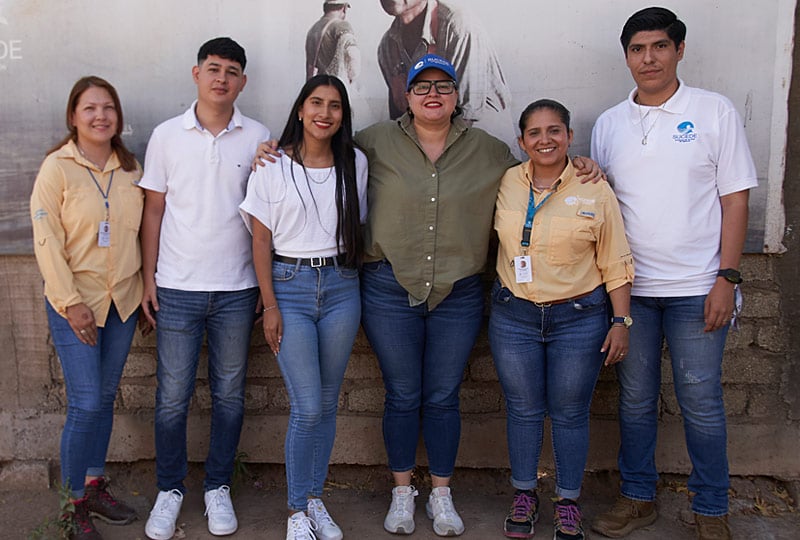
The team from Sociedad en Acción de Sinaloa (Sucede), an organization dedicated to restoring Santa María Bay, works to improve environmental conditions and support local fishing communities. From left to right: Alejandra Valenzuela, Ramón Eduardo Hernández Montoya, María Guadalupe López Gutiérrez, Isabel Mendoza, Areli Coronado, and Víctor Manuel Meza Castro.
Photo: Eunice Adorno
It was on this ground that the idea of forming an oyster-farming cooperative first took root. “Women weren’t given opportunities, so we joined Sucede,” says Magdalena, better known as Chita Burgos. “We attended a course on reconciliation and forgiveness; from there, we all came together and felt that spark—the urge to start a cooperative with gender equity.” The association provided them with legal guidance, while the Santa María Sea Food company trained them in oyster cultivation.
Community work was, in fact, the first step toward change. In 2023, they received their articles of incorporation and began their first planting: 3.5 million oysters, which they tended until they matured for Santa María Sea Food. The company supplied larvae, trained them, and paid 50 cents per oyster. More than a source of income, the experience gave them confidence—it proved they could produce at scale and sustain a project of their own.
The Leonor Cuadras Cuadras Cooperative puts into practice some of the pillars proposed within the Marine Prosperity Areas (MPpAs): it organized its economy around oysters; generated employment during the shrimp and crab closed seasons; and, at the same time, contributed to wetland regeneration.
In 2024, they planted another million oyster seeds in the cultivation area set up on Espíritu Island. This time, it wasn’t for sale, but part of a complementary restoration effort. As they grow, these filter-feeding mollusks help purify the bay’s waters, fostering the recovery of other species and making the ecosystem more productive—with the future in mind. “That’s what we want: to help the environment and make the waters cleaner,” says Chita Burgos.
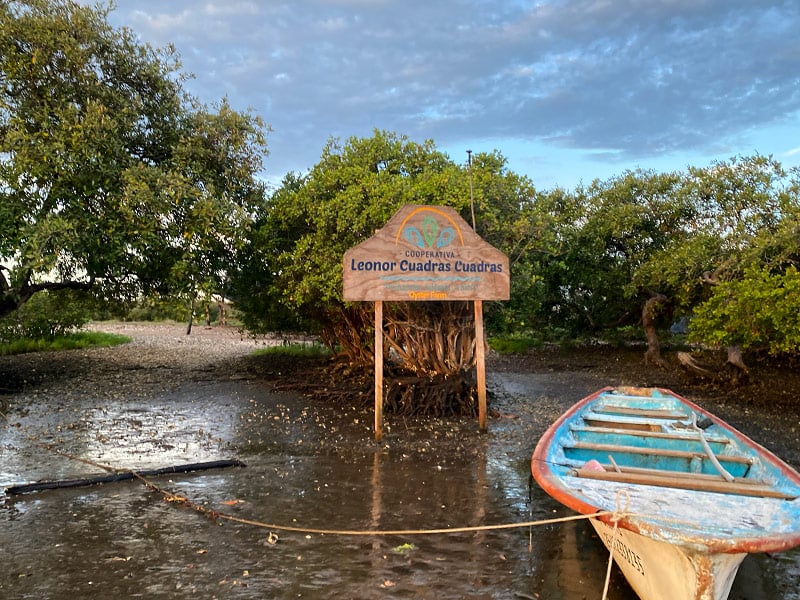
Amid the mangroves of El Espíritu Island in Santa María Bay, Sinaloa, stands the sign of the Leonor Cuadras Cuadras Oyster Cooperative—the first in the state made up entirely of women fishers. Beside it rests the small boat Ángela, used to navigate the oyster farming lines, a testament to these women’s commitment to sustainable aquaculture and the conservation of their environment.
Photo: Ramón Eduardo Hernández Montoya
They know the community’s survival depends on the bay—and the bay, in turn, depends on the community to protect its mangroves, islands, islets, dunes, and coastal lagoons, which together stretch across 67,000 hectares in the municipalities of Navolato, Angostura, and Guasave.
In La Reforma, a town that lives primarily from fishing, the members of the Leonor Cuadras Cuadras Cooperative are charting a new course for conservation. In just six years, they have gone from being dismissed to leading the protection of Santa María Bay, declared a protected natural area in August 2001.
In August 2025, the women of the cooperative once again mixed corn and wheat flour—just as their mothers and grandmothers did—to bake cookies and empanadas. There was no work, neither on land nor at sea. Shrimp was in its closed season, crab catches barely brought in anything, prices had been stagnant for years, and diesel costs kept rising.
They and their community are searching for ways to survive in a climate of insecurity that keeps them from getting into a boat—or even walking down the street—without fear. Since drug-related violence erupted in Sinaloa in September 2024, everything has changed: shootings, disappearances, kidnappings. In La Reforma, families know that any day can be cut short by a new act of violence—and that everyday life depends on "the situation calming down."
That's why, in the last two months, they haven't returned to the oyster beds to work either; the oysters have been left unattended.
Investors interested in hiring the cooperative have also not returned; they are waiting for security conditions to improve before resuming business and allowing production to continue.
Amidst this uncertainty, the women hold on to what they have—their hands, their recipes, their community. Tamales have now joined the list of activities to earn a little extra income. “We’re warriors,” says Chita Burgos with a laugh—though she means it.
She and her fellow members haven’t lost hope that the violence will give way to calls for peace, and that they’ll soon be able to return to small-scale fishing—a sector in which women make up 90% of the global workforce, according to research published in Nature.
As they wait for that moment to come, the women focus on adapting and keeping a positive outlook—especially after receiving their own motorboat on August 26 through a state support program that covered half the cost. The cooperative paid the remaining 140,000 pesos with the earnings from their first oyster sale.
Step by step, they have built the foundations that uphold the Marine Prosperity Areas. First came community participation—through workshops, organization, and the autonomy to speak up and make decisions. Then came capacity building and governance, strengthened by training, legal support, and new alliances. And although there is still a long road ahead—establishing clear local governance frameworks, conflict-resolution mechanisms, and infrastructure to diversify income, such as ecotourism—they have already begun writing a different story: one in which the future of the bay and the community pulse in unison.
In the waters of Santa María Bay, other hopes also set sail: pangas that no longer head out to fish for shrimp, but to showcase birds, islands, and sea turtles—as if each species were a reminder of what remains to be protected.
La Reforma is known for having some of Mexico’s richest fishing grounds and for distributing blue shrimp, the species with the highest commercial value. But when shrimp and crab closed seasons overlap, the bay falls almost silent: pangas are few, and work is minimal. It was then that Adalberto García Domínguez and a group of men and women decided to open another door—forming an ecotourism and sport-fishing cooperative offering tours of Santa María Bay, a feeding and resting site for over 500,000 shorebirds and thousands of waterfowl.

The boardwalk in La Reforma, adorned with a bird sculpture, celebrates the ornithological richness of Santa María Bay. This region, home to thousands of migratory birds, offers vast potential for sustainable ecotourism.
Photo: Eunice Adorno
They named it Brianta del Pacífico, in honor of the Canada goose—a migratory bird that arrives every winter from Canada and rivals the blue-footed booby in local popularity. These native species have chosen the bay’s islands as one of only three nesting sites in the world. Eight women and sixteen men from the community take part in the project.
From his boat, Adalberto shares his knowledge of the birds and explains the importance of the Islands of the Gulf of California Flora and Fauna Protection Area. He also speaks about his work in sea turtle conservation.
He talks about them with reverence. “They’ve overcome so many, countless obstacles,” he says. “In a way, I feel connected to them. I often wonder what those animals have seen out there in the ocean—what they’ve witnessed that we haven’t. They fascinate me, and I admire them for being true warriors of the ecosystem. We must learn from them.”
The fisherman from La Reforma is part of the Marine Turtle Monitoring Network of Grupo Tortuguero de las Californias and the Sinaloa Turtle Network (Retos)—initiatives dedicated to collecting data on migration, nesting, and threats to better protect these species. With support from the Interdisciplinary Research Center for Integral Regional Development (CIDIIR), the National Commission of Natural Protected Areas (Conanp), and Sucede, he learned to tag and attach satellite transmitters to turtles that enter the bay to feed, as well as to measure their shells and share the data with the scientific community.
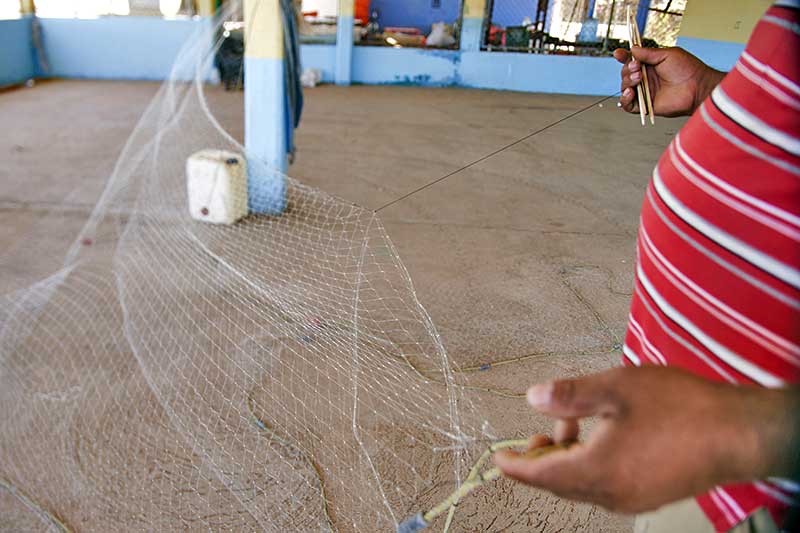
A fisherman from La Reforma patiently mends his nets. The inactivity in Santa María Bay, marked by fishing bans and insecurity, forces many to wait on land before being able to return to sea.
Photo: Eunice Adorno
That same commitment takes him into classrooms. In local elementary schools, Adalberto sits in front of children to share what the sea has taught him. Meanwhile, the women of the cooperative and young volunteers lend their voices to environmental education programs. Gradually, each new generation begins to see the bay not only as a source of livelihood but also as a living territory—one where their future prosperity depends on caring for what gives them life.
Brianta del Pacífico is a reminder that the sea not only provides work—it also teaches. Each tour, each tagged turtle, and each named bird becomes a lesson the community transforms into collective strength. In La Reforma, they know that the future depends not on what is fished or harvested, but on caring for what makes life in the bay possible. And in that constant ebb and flow, among oysters, birds, and turtles, the community has found a germinating idea that keeps it afloat.
From Punta Chueca, on the coast of Sonora, a people once on the brink of extinction have become a beacon—proof that ancestral wisdom, contemporary science, and civic organizations can come together to protect territory and rebuild the bond between the sea and those who live by it.
By Iván Carrillo
The words are unintelligible, but the song is melodious and deep. Valentina Torres Molina keeps it alive as part of a tradition that refuses to vanish. In Punta Chueca, Sonora, the sand blends into the marine horizon and the air scorches the stones. In summer, temperatures climb past 40 degrees Celsius (104 Fahrenheit). On the horizon rises Tiburón Island, Mexico’s largest—Comca’ac territory since before written records existed.
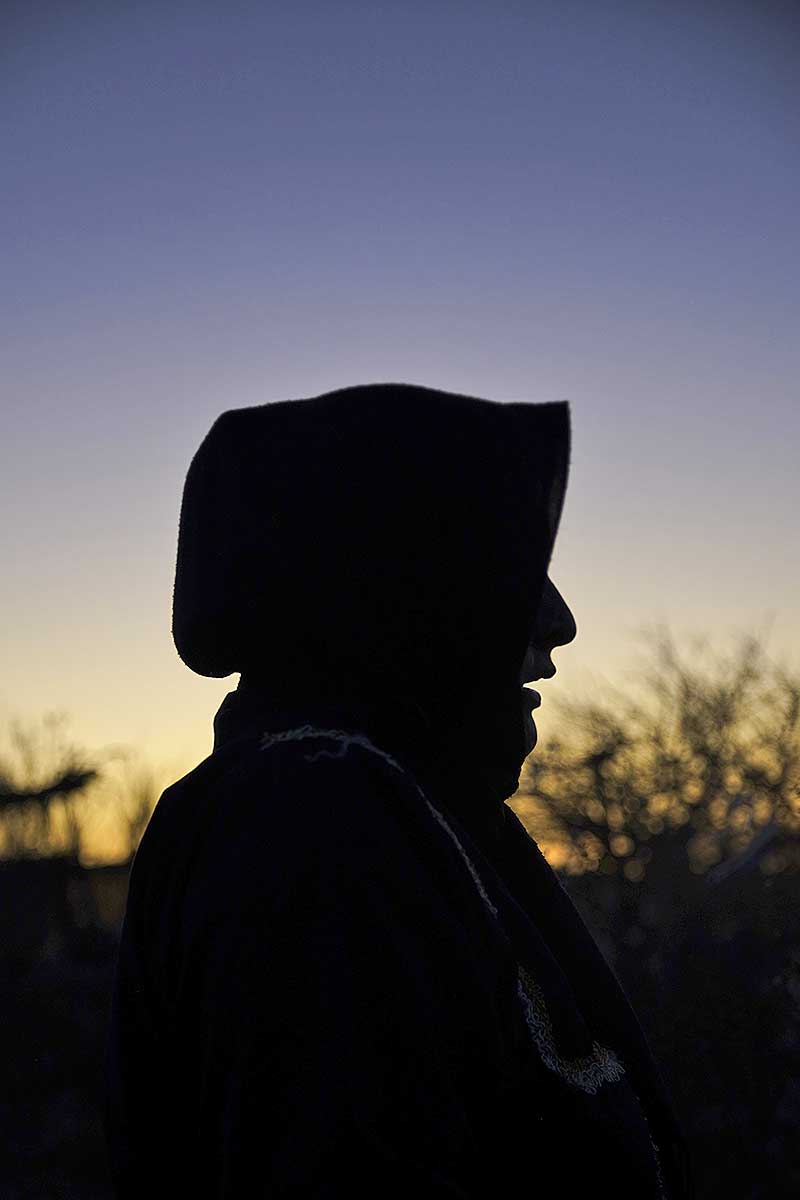
Valentina Torres observes Tiburón Island, the largest in Mexico and part of the Comca'ac community's territory. The island is a geographical and cultural pillar for these people.
Photo: Eunice Adorno
Valentina’s voice carries an ancient rhythm. She narrates the journey of a man who confronts ocean currents and invokes a word to calm the wind and return home safely. The origin of the tale is lost in the distant past of this amphibious people—nomads of the desert, and fishers by fate. Valentina is dressed in black. A veil covers her head. Her dark, serene eyes are fixed and unhurried. She embodies women, resistance, and memory. Her words recall a time when a tsunami turned giants into all living beings that now inhabit the world. That, she says, is where her people’s story begins.
The history of the Comca'ac, or Seri, is shaped by the heat and scarcity of the desert. Their relationship with the territory was not one of dominion, but of understanding. That legacy — their language, songs, herbal medicine, astronomy, knowledge of tides and sea cycles —remains the foundation of their survival today. It is the point where ancestral knowledge meets Western science to reinvent conservation.
But resistance carries a cost. The Comca’ac now face a landscape of threats: collapsed fisheries, unregulated tourism, pollution, language loss, and weakening ties to their territory. Decades of institutional neglect have compounded their poverty and oblivion.
And yet, amid desolation, Valentina’s song endures—her voice linking past and present, reminding us that conservation cannot be imposed by decree.
The Intergovernmental Panel on Climate Change (IPCC) recognizes that indigenous and local knowledge is fundamental for climate change adaptation and resilient development. This principle resonates in conservation initiatives that merge science with the inherited wisdom of coastal communities—placing people at the heart of environmental management.
Punta Chueca could become part of this movement. Efforts to integrate Comca'ac knowledge with modern science point toward the same horizon that inspires the concept of Marine Prosperity Areas: territories where conservation becomes a tool for development.
"We have been conservationists before we knew it," says Aaron Asael Barnett, a young community leader. “Our grandparents were already naturalists who, without realizing it, practiced the philosophy of taking only what was necessary.”
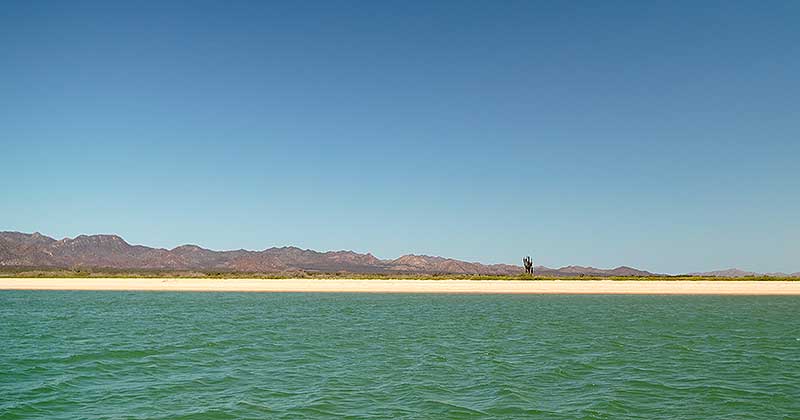
The desert landscape meets the sea in Comca'ac territory, illustrating the uniqueness of this "amphibious people" whose culture has been forged between both ecosystems.
Photo: Iván Carrillo
The Comca'ac history is one of resistance. Since the arrival of Europeans, evangelizing the Indigenous population proved impossible: between 1678 and 1772, missions were established only to be abandoned or destroyed. The Seri, as they were then called, rejected sedentarism, agriculture, and livestock farming—practices alien to their culture and difficult to sustain in an arid desert.
The colonial and the 19th century were merciless: epidemics, military campaigns, deportations, and miscegenation decimated the population until, in the 20th century, only a small group—the remnants of the original communities—continued to defend their cultural autonomy.
Luis Moreno, a sociologist and coordinator of the Indigenous Community Collaboration Program at Prescott College’s Bahía Kino Center for Cultural and Ecological Studies, puts it succinctly: “Their resistance stems from a profound understanding of the environment, of history, and of the past, passed down by ancestors and grandparents.” Comca’ac leaders confirm this, seeing themselves as guardians of an ancient lineage where the ancestral and the Western are not opposed but complementary, walking the same path.

A Comca'ac community leader displays the lines symbolically drawn on the face during the New Year celebrations, the Haaco Camaast. This ancestral ritual connects the community with its cultural heritage.
Photo: Iván Carrillo
This vision of continuity between tradition and modernity became the foundation for projects that would emerge later.
The memory forged through centuries of adversity has been renewed in the face of new threats. The Comca’ac live in constant tension between the past they protect and the present that presses upon them. Waters that once sustained life for generations are running dry. Fishermen in the Canal del Infiernillo say with resignation that each year they catch less, and with greater effort. The once-abundant crab fishery has collapsed, and overexploitation has disrupted the ecosystem's balance.
Illegal fishing and poaching have further undermined their efforts to maintain control. Within the community’s exclusive fishing zone, outside boats operate freely, and abandoned nets, waste in the mangroves, and trash-clogged estuaries attest to insufficient vigilance. As Humberto Romero, one of the community leaders, warns, “Poaching quickly destroys populations—on land and under the sea alike.”
To this, a harsher truth is added: Comca’ac territory, like many regions of Mexico, has been swept by waves of violence, drug trafficking, and conflict with industrial fishing fleets—scenarios where survival demands both resistance and prudence.
And climate change exacerbates everything. Shifts in water temperature, pollution, and biodiversity loss are undermining the very foundations of subsistence. Yet perhaps the deepest wound lies in memory. The rapid loss of language and traditional knowledge threatens to sever the threads that bind generations. Elders fear that if young people stop learning the names of species and reading the tides, the very way of understanding and caring for their world will also be lost.

Fishing is the central economic pillar for the indigenous Comca'ac in Punta Chueca, generating family and community income. Their direct subsistence and local/regional trade depend on the capture of species such as purple snail, pen shell, shark, chano, crab, shrimp, sierra, and other scaled fish.
Photo: Eunice Adorno
Global figures reveal the scale of the crisis: current extinction rates are 114 times higher than the historical natural rate for vertebrates, even by the most conservative estimates. Fish stocks continue to decline—unsustainable exploitation has risen from 10% in 1974 to 35.4% in 2019—a process of depletion that advances in step with cultural erosion.
Science has proven that biological and linguistic diversity are deeply intertwined. According to the 2015 study Endangered Languages by Rogers and Campbell, one language now vanishes every three or four months. Of the planet’s 6,901 living languages, more than 3,100 are endangered. Each lost language erases a unique way of naming and understanding nature.
In the past 500 years, at least 73 genera of vertebrates have gone extinct—a process that, under natural conditions, would have taken roughly 18,000 years.
In recent decades, resistance has evolved into awareness and organization. The ecological crisis of the Canal del Infiernillo is no longer seen as an external threat but as an internal fracture. “The shift in mindset comes from the people themselves, as they witness changes in the environment where they work,” explains Gregory Smart, Assistant Director of Operations at Prescott College’s Bahía Kino Center for Cultural and Ecological Studies.
Fishermen were the first to witness this transformation. But ecological strain was not the only warning sign; the elders began to notice something even more profound—the fading of ancestral knowledge. Their fear that young people would cease recognizing plants, winds, or stars marked the beginning of a new chapter led by a generation raised on desert stories yet fluent in the language of science.
“I feel proud and deeply committed to helping our community and our territory find ways to keep protecting—to preserve part of our culture and ancestral knowledge,” says Aaron.
Such transformations do not happen overnight. Lorayne Meltzer, Executive Director of Prescott College’s Bahía Kino Center for Cultural and Ecological Studies, has witnessed it firsthand for over two decades. Sitting in her office—a space filled with images of the region’s biodiversity and the programs she leads—she recalls that the community “always had the gift, knew where it wanted to go, had the knowledge, but lacked the impetus to put it into practice, to connect traditional knowledge with action.”
That is where institutions play a crucial role, Meltzer insists, noting that truly sustainable processes “are not built in months, but over decades.” And that, she adds, is precisely what has unfolded in Punta Chueca: a community that has moved from resistance to action without losing its essence. One example is the Biocultural School—a learning experience that bridges generations.
The Biocultural School was founded in 1998, led by cultural ecologist Laura Monti, ethnobiologist Gary Nabhan, and a group of community elders including Nacho Barnett. “Originally, it was a project for ecologists,” Lorayne recalls, “where wise mentors—community elders—worked side by side with biologists and Western experts.”
Its goal was to unite traditional and scientific knowledge to protect the territory from a cultural perspective using modern tools. Over time, this vision took root among younger generations. “I’ve learned to combine monitoring techniques for fish, mollusks, turtles, birds, plants, and geology with the traditional knowledge I received from my elders,” says Aaron.
What happens in this biocultural school is unique. Classes include walks through the desert to identify plants, trips to the Canal del Infiernillo to study currents and wildlife, field data collection, and oral storytelling sessions. Mentors such as Humberto Romero teach botany, René Montaño transmits stories, astronomy, and language, and Valentina Torres Molina preserves traditional songs and crafts. It is a pedagogy in which learning is intertwined with the territory.
“You have to treat the mountains, the plants, and the sea as if they were part of your own being,” says Montaño. Romero sums it up in one idea: “The species must be the boss, not the people.”

René Montaño, a Comca'ac leader and expert in botany and astronomy, teaches classes at the Biocultural School. This project integrates ancestral knowledge with contemporary science for territorial conservation.
Photo: Iván Carrillo
The results are visible. The Biocultural School began training a new generation of conservationists to monitor birds, turtles, and plants. Furthermore, it has contributed to preserving their language and stories. In its most recent program, the classroom brought together 30 children and young people, who joined the Punta Chueca Turtle Group on field expeditions, recording 27 sea turtles in the Canal del Infiernillo.
Among those accompanying this process is Crisol Méndez Medina, Assistant Director of Conservation Programs at the Prescott Center. With deep, clear eyes, she has devoted her life to understanding the dynamics of fishing communities and demonstrating that collaboration and organization emerge from the shared work of many actors. For her, the goal is not to idealize communities but to support them through institutions that help build solid and sustainable structures.
“The community is the foundation and the key ingredient,” she explains, “but it needs the accompaniment of other actors—academia, NGOs, and government—capable of providing data, managing laws, and consolidating protection tools.”

Alissa López Barnett, a young Comca'ac, works with sanitation and ecological groups in her community. Her connection to Tiburón Island, the largest island in Mexico (1,208 km²), is significant; the Seris have managed this sacred and culturally important territory in coordination with federal authorities since its declaration as a Biosphere Reserve and Flora and Fauna Protection Area in 1963.
Photo: Eunice Adorno
These programs have demonstrated that conservation is not a discourse but a practice—something that can be counted, weighed, and measured. During the 2023–2024 season, this collaboration resulted in 13 community projects involving over 150 community members. Planning was rigorous: six workshops with 72 community members helped define management priorities for the Canal del Infiernillo Ramsar Site.
The new generation has learned to merge the wisdom of the wind with monitoring protocols, the song of birds with scientific datasheets, and memory with measurement. Today, they know when a mollusk needs to rest and when it can be harvested—and how tides and seasons intertwine with the rhythms of species.
Other initiatives are also unfolding across the region. The Punta Chueca Turtle Group, for instance, conducted eight monitoring expeditions with 27 turtle sightings in the Canal del Infiernillo. Meanwhile, Coijaac, another local group, completed 52 aquatic bird censuses in estuaries and channels, blending the observations of elders with modern biological tools.
In Bahía de Kino, the recovery of Laguna La Cruz—a Ramsar Site crucial to the balance of the coastal ecosystem—continues thanks to the voluntary and organized efforts a group of fishermen with a renewed ecological awareness. In recent years, 11 community projects focused on managing and protecting the wetland have been implemented. Among them, Padres Unidos stands out: a group that has carried out 24 coastal and shoreline cleanups to safeguard the lagoon and foster environmental awareness.
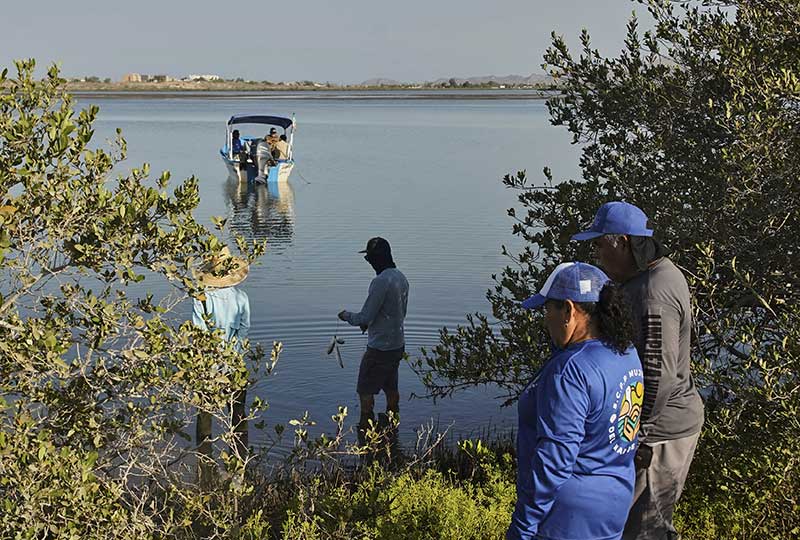
Members of Padres Unidos de Bahía Kino visit La Cruz Lagoon, a Ramsar wetland essential for the reproduction of birds, fish, and invertebrates, many of which are of commercial importance. This community group is dedicated to the conservation of the lagoon and its surroundings, focusing on the protection of marine biodiversity and the surrounding desert vegetation.
Photo: Eunice Adorno
In 2016, the study “The Importance of Indigenous Knowledge in Curbing the Loss of Language and Biodiversity” was published in the journal BioScience. It was not a desk study, but a chronicle born of collaboration between scientists and desert connoisseurs. The Comca’ac case exemplified how ancestral knowledge can be both precise and vast.
For the first time, Cmiique Iitom terminology—the language of the Comca’ac—was placed on equal footing with Linnaean nomenclature. Young “paraecologists” and elders participated as co-authors, writing science in two alphabets: academic and ancestral. Place names such as Tosni Iti Ihiiquet (“where the pelicans have their offspring”) for Isla Rasa, confirmed by 19th-century records, demonstrated the accuracy of Indigenous knowledge—even when bird colonies have since vanished.
In other instances, the Comca’ac perspective guided unexpected discoveries: wild populations of tepary beans (haap) in remote corners of Tiburón Island, or wintering groups of sea turtles once believed to migrate beyond the region.
This knowledge has now been cataloged: 291 Comca’ac names for plants and 264 for mollusks. The study also recovered the symbolic value of storytelling. Songs about marine creatures and mythological reptiles—narrated by mentors like René Montaño, and the melodies that Valentina Torres associates with each species—form part of a living fabric where biology and spirituality intertwine.
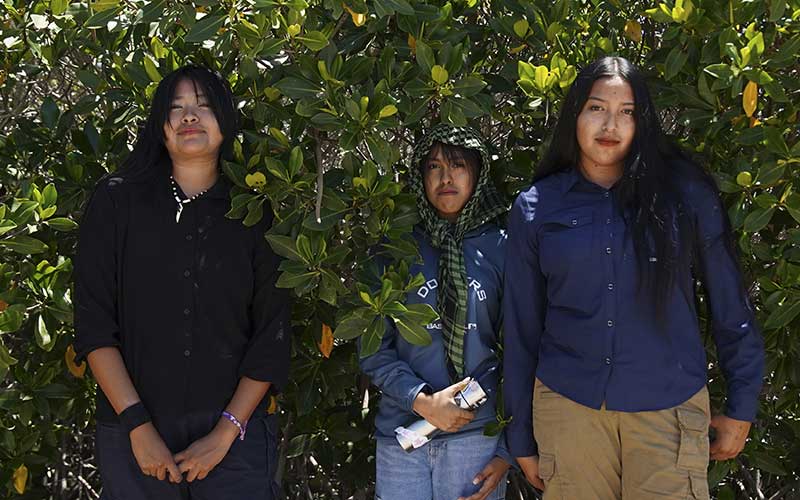
Helen López Barnett, Yaritza Torres, and Alissa López Barnett are young Comca'ac who actively engage with ecological programs in their community. Their participation is fundamental for preserving and consolidating new environmental knowledge, integrating it with the ancestral wisdom passed down by their elders, thus ensuring the cultural and ecological continuity of their people.
Photo: Eunice Adorno
Traditional knowledge not only complements but often precedes science. This was the case with the divergence of spiny iguanas between islands, a fact long intuited by the Comca’ac and later confirmed through genetic analysis. Even when stories and scientific data diverge—as in the case of the bighorn sheep of Tiburón Island, whose oral histories trace their presence 1,500 years ago, unlike the official theory of their 1975 introduction—the result is not a contradiction, but a new question.
The article concludes with a warning that now reads like a prophecy: “The loss of Indigenous languages is equivalent to the loss of entire libraries of ecological knowledge.”
In the 1930s, the Comca’ac were on the verge of disappearance—their population had dwindled to barely 200 people. Today, nearly a century later, they are just over 1,000. This demographic recovery has gone hand in hand with a process of cultural reaffirmation and territorial protection. In 1975, a presidential decree formally recognized the communal property of Tiburón Island and the Canal del Infiernillo, establishing the island’s coastline as an exclusive fishing zone.
Shortly after, the Reserve and Refuge Zone for Migratory Birds and Wildlife of the Gulf of California Islands was established.
In the 1990s, Tiburón Island and the Desemboque ejido were registered as Environmental Management Units (UMAs) by Mexico’s Secretariat of Environment and Natural Resources. This registration underscored the bighorn sheep conservation program, which operates through regulated hunting practices with permits that can cost up to $90,000 per specimen.
More recently, the protected area of the Gulf of California Islands was reclassified as a Flora and Fauna Protection Area by the National Commission of Natural Protected Areas (Conanp). And in 2009, the Canal del Infiernillo Wetland and the estuaries within the Comca’ac territory were designated as a Ramsar Site.
Between decrees, certifications, and protection categories, the territory has accumulated legal recognitions that support what its celebrations and rituals proclaim each year: that its bond with the land and the sea is as ancient as it is enduring.
Every June 30th, when the sun seems to stand still on the horizon and the landscape falls silent under the heat, Punta Chueca and Desemboque celebrate Haaco camaast, the Comca’ac New Year. It is an ancestral ritual where women wear multicolored dresses, men carry amulets, and their faces are painted with colored lines across the cheekbones. The air fills with the scent of turtle soup—whose consumption is permitted here by ancestral tradition—and the sweetness of pitaya wine, made from a fruit that ripens precisely in this season.

A group of Comca'ac women, dressed in their ceremonial attire, participate in the celebration of Haaco Camaast, the Comca'ac New Year. This ancestral ritual, celebrated every June 30th, reaffirms the cultural and spiritual bond of the people with their territory and traditions.
Photo: Iván Carrillo
The songs are transmitted through modern loudspeakers. The voices of elder women drift across the desert and the sea. At the same time, visitors from Hermosillo or Tucson listen intently, seeking to reconnect their urban lives with a spirituality that seems never to have been extinguished.
As night falls, the wind rises from the Canal del Infiernillo, and the voices dissolve into the air. Now the rock band Hamac Caziim (“Divine Fire”) takes over the soundscape with pounding drums, distorted guitar chords, and original verses in Cmiique Iitom. The atmosphere evokes a living culture adapting to modern times without abandoning tradition. Then Valentina’s song returns to my memory—both ancient and present—telling of a man’s journey battling the currents to return home. A metaphor for this people who have learned to row against oblivion, to summon the word, and to return, again and again, to their origin.

Ribbons with the colors of the Comca'ac (Seri) nation's flag—red, white, and blue—are displayed as part of the Haaco Camaast celebration, the Comca'ac New Year. Red symbolizes strength and courage; white, purity and spirituality; and blue, the sea and the sky. Celebrated between June 30th and July 1st, this event marks the arrival of the first rains in the Sonoran Desert and a natural cycle of abundance. The afternoon included dances, songs, and rituals of gratitude and community strengthening by the sea, honoring the cyclical time of the desert and Comca'ac cultural autonomy.
Photo: Eunice Adorno
A collective of twelve women in Baja California Sur has turned environmental defense into a model of self-management and empowerment—confronting stigmas and reclaiming a vital ecosystem through ecotourism, oyster farming, and mangrove restoration. Their struggle for the sea is also a battle for their voice and their future.
By Aminetth Sánchez
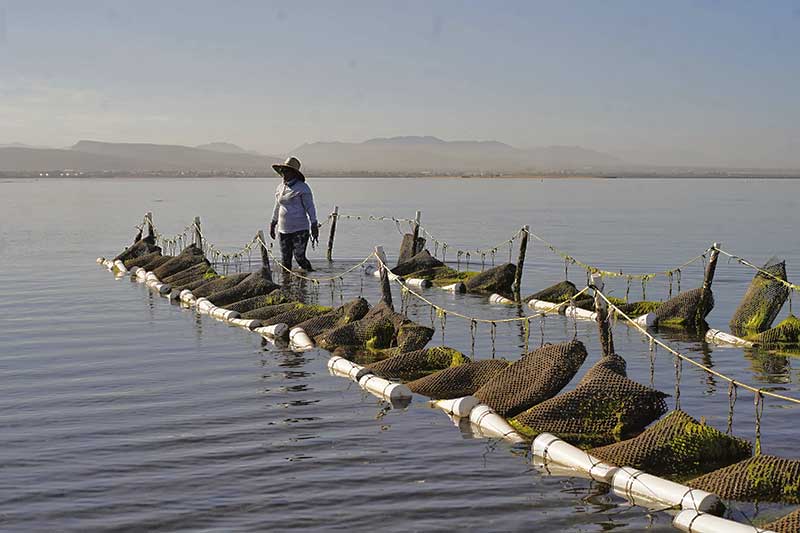
Aracely Méndez is part of Guardianas del Conchalito, a women’s cooperative dedicated to protecting the mangrove ecosystem. They monitor and report illegal logging, poaching, and the dumping of waste in the estuary. The collective also cultivates oysters in hanging lantern cages, where the mollusks feed on natural nutrients while helping to clean the ecosystem. This sustainable practice allows them to generate local income and care for their environment.
Photo: Eunice Adorno
—"Oh, honey, it's her baby!"—shouts Martha García Juárez.
The panga stops. A few meters away, a dolphin slowly moves forward with a dead calf clinging to its snout. For two days, the mother has dragged the small body without letting go. Another dolphin—probably the male—swims beside her. The calf is beginning to decompose, but the mother insists on carrying it. The cause of death remains unknown.
In the boat, Martha and Araceli Méndez Márquez watch in silence. Both belong to the Guardianas del Conchalito, a collective of twelve women who monitor the estuary, clear channels to restore mangroves, manage the state’s first nursery, cultivate oysters, and lead ecotourism tours in La Paz, Baja California Sur. They are defenders of their territory and lovers of the sea, convinced that caring for it means caring for themselves and their community.
They wonder whether to intervene. Martha answers without taking her eyes off the water:
“She’s saying goodbye.” The scene occurs at Nayarit beach. What was supposed to be a routine trip to the oyster farm becomes an unexpected interlude—a quiet reminder of life and death in the sea they have learned to protect.
At first, no one took them seriously. The sea, people said, was men’s work. Women were welcome on the pangas—but not to make decisions.
For years, they worked within those limits. They accompanied the men, fished, sold the catch, and filleted the fish—nothing more.
“It was normal for us to be on the pangas,” says Martha, general coordinator of the Guardianas. “I used to handle the sales. Yes, we killed, yes, we filleted—but when we started to become partners, that’s when the problems began.”
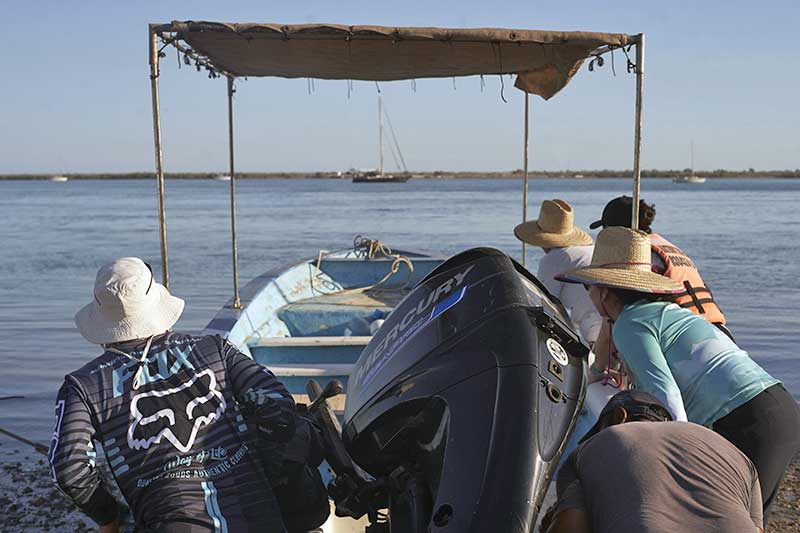
Members of Guardianas del Conchalito, a collective that has restored 70% of the estuary’s mangrove forest, prepare their boat for a workday.
Photo: Eunice Adorno
That “problem” began when five new positions opened in the Organization of Fishermen Rescuing the Ensenada (OPRE)—a local initiative formed by the community of El Manglito to restore and manage the Ensenada de La Paz sustainably—and they were given to women.
It was their first formal entry as partners. What looked like recognition quickly turned into a fight for legitimacy. They held positions, attended meetings, signed minutes—yet still couldn’t make decisions. “We weren’t heard,” Martha recalls. “We were on the board, we had official roles, and still, our voices didn’t count.” The exclusion became a form of daily violence. More than one considered walking away.
At the same time, another front emerged—one that would change everything: the El Conchalito estuary. Illegal scallop fishing was concentrated there, and that’s why the women decided to act. In 2017, they began patrolling the area—first under OPRE, and later as an independent collective.
Their first task was surveillance: daily rounds to stop illegal extraction in a site already damaged by siltation and looting. Their presence was unsettling. Seeing women in authority was, for many, unacceptable.“There were taunts, shouts, insults,” recalls Rosa María Gil, coordinator of the Guardianas’ nursery. “They would yell: ‘Bring your husband! Go wash the dishes! What are you doing here?’”
It wasn’t just verbal hostility; the area was marked by violence and neglect.
“It was scary to be here. It was dark, desolate. A lot of palomilla—fishermen—would come into the mangroves to use drugs. We confronted many illegal operators,” recalls Rosa María Gil, better known in El Manglito as Doña Rosa.

Martha Magdalena García Juárez, president of the Guardianas del Conchalito cooperative, leads monitoring and reporting efforts against illegal logging, poaching, and waste dumping in the estuary.
Photo: Eunice Adorno
The Guardianas stayed despite the fear, convinced that their presence itself was a form of defense. And that persistence began to change everything. “Because we were here, Conanp (the National Commission of Natural Protected Areas) noticed us. Now we co-manage the area and keep it clean,” says Doña Rosa.
What began as an uncomfortable task eventually opened the door for them to be recognized as legitimate actors in the defense and restoration of the estuary.
The work was arduous—and transformative. Doña Rosa states it clearly:
“Before, I was very submissive. I did what my husband said; I didn’t know my worth. Now, no—I’m equal to anyone. Before, my children would laugh and say we were just going to play bingo. Now they see us on Facebook and say, ‘That’s my mom. I’m proud.’”
Martha sums it up with the same conviction: “I am Martha. I’m not Juanito’s wife or Andrea’s mother. I’m Martha. No one speaks for us anymore. We learned to believe in ourselves—and that was the hardest part.”
The estuary stopped being a place of plunder. Illegal fishing waned, and with it, the notion that women were meant to watch from the sidelines. The Guardianas rediscovered themselves as protagonists—women capable of monitoring, deciding, and sustaining a territory that had long been denied to them.
Water returns where it can. Sometimes it needs someone to open a vein for it. In El Conchalito, the Guardianas and a group of young volunteers dig into the earth with picks and shovels so the sea can breathe again. Daniela Bareño, 35, puts on her hat. “Let’s go to the channels,” she says. She is the group’s tourism and environmental education coordinator—she walks fast, talks just as quickly. With one hand, she traces the estuary’s map in the air.
“With pick and shovel,” she repeats proudly, because heavy machinery is forbidden in the area.
This place was once called Estero San Martín. Now it’s El Conchalito, named after the shell mounds left by its earliest inhabitants. In the 1980s, a dense mangrove forest thrived on the tides. Seawater flowed through natural channels, keeping the soil moist, oxygenating roots, and feeding life. Today, only 30% remains. The other 70% died, smothered by silt and urban waste that blocked the tidal veins.
“When it rains in the city, everything—mud, trash—flows downhill into the sea,” Daniela explains. “These tidal veins got blocked, the water stopped circulating, and the mangroves died. The soil turns hard, like cement.”
Before picking up tools, the Guardianas sought advice from Costasalvaje and Leonardo Moroyoqui Rojo, a biologist specializing in mangrove restoration at the Humedales Sustentables organization. His diagnosis: eleven tidal channels within the polygon were clogged. With that report, they obtained permits from Conanp to reopen up to one kilometer of channels—manually. “We didn’t know anything about permits before,” Martha laughs. “Now we write our own official letters; we know what to ask for and how to ask for it.” They started in April. So far, they’ve opened 90 of the thousand authorized.

A hydrological channel restored by Guardianas del Conchalito in Baja California Sur. The collective reforests the estuary by reopening channels and managing nurseries for red, black, and white mangroves, while monitoring their growth. The ecosystem is home to three of the four protected mangrove species, as well as numerous bird and crustacean species.
Photo: Eunice Adorno
The first channel has its birth certificate nailed to a wooden post. Hand-painted letters read:
‘First Hydrological Channel – April 23, 2024’. Below are the names of its creators: Guardianas del Conchalito, Costasalvaje, and Conanp. Behind it, a narrow ditch glistens with moisture. When the tide rises, it becomes a stream. The water enters as if remembering home—soaking roots, darkening the soil.
“Something so simple, and it changed everything,” Daniela says. “Now the tide reaches areas that were once dry. We’re seeing more marine life—shrimp, fish, crabs—things we hadn’t seen this close in years.” She walks across the wet, slippery soil—a living symbol of restoration. Nearby, stakes mark a new beginning: the thick-billed plover has started nesting again.
The first channel has already received maintenance; it needs it annually. At low tide, the water looks murky, but the system moves and brings treasures: crabs, glasswort (a genus of succulent plants that grow in salt flats), and mangrove seedlings. Daniela explains the technical aspects: "We take measurements with hoses to determine levels. If the water stagnates inside, it becomes salty and useless. We have to give it a slope so the tide can enter and exit." This first channel is 46 meters long, 70 centimeters deep, and 1.5 meters wide.

One of the “veins” reopened by Guardianas del Conchalito shows the flow of water returning to the ecosystem. Restoring water circulation has brought life back to the estuary, fostering biodiversity and the growth of local flora and fauna.
Photo: Eunice Adorno
Further ahead lies the second channel, opened in 2025. Daniela points at a dark line of moist soil. “The tide now reaches here. See that wet edge? It used to be all dust.”
Everything is the result of the Guardianas and the young volunteers. For what’s left to open, the plan remains the same: work alongside the young volunteers, this time in the El Mogote area, where they’re preparing a new one-kilometer channel. They handle the permits, logistics, and schedules—and when the time comes, they get in the mud too.
There are no lounge chairs or all-inclusive resorts here. Nor do they sell postcards or souvenirs. Here, tourists are put to work.
“Tourism in Baja is usually about appreciation — visiting a landscape, being on the beach, enjoying its beauty. But here, we want to put you to work, to make you feel useful, to leave your mark, your grain of sand as you pass through — to come, clean, conserve, and carry that message to new generations about how to care. So it’s a totally different kind of tourism,” Daniela explains. “Ours is ecotourism — focused on education.”
The Guardianas welcome groups and organize tours that begin with a simple invitation: “Let’s go to the estuary.” The goal is not to watch from afar, but to understand with one’s hands. Ecotourism, they say, is focused on education.
The tour starts in the nursery. Doña Rosa teaches where to plant and where not to — mangroves aren’t planted randomly. Then comes the estuary: bird-watching, understanding the hydrological channels and their purpose. There, they explain why the channels were opened, where they were blocked, and what caused the tide to recede.
Then comes the mud — not for a photo, but for work. Cleaning, digging, learning the rhythm of the shovel. The Guardianas visit an area where small mangroves grow naturally, keeping the site clear and returning water to it. They also visit the section where they cultivate oysters.
It is not appreciative tourism; it is not just going to the beach. Visitors leave a mark: they collect, conserve, and carry the message onward. “This year, 200 young people have joined the Guardianas tour, always with the idea that they can protect, care for, and understand the importance of these ecosystems — and that those of us who visit them can also help preserve them,” Daniela says. That lesson stays with them.
The heart of the tour is also the heart of the organization: the mangrove nursery — the first in all of Baja California Sur. It was established in 2023 with support from Costa Salvaje, and since then, four Guardianas have cared for it daily. One of them is Doña Rosa, who, at 64, smiles as she says: “I’m the nursery coordinator. They call these my children, because every mangrove I see grow fills me with pride.”
The routine is sacred yet simple: watering every third day, mixing soil with fresh and saltwater, compost, and leaf litter. The first planting was all trial and error, but experience turned them into skilled caretakers.
“At first, we watered them only with fresh water, and they started drying up. Andrea — Martha’s daughter — told us we had to add saltwater once a week, and look how beautiful they are now,” Rosa says, stroking a green stem.

The mangrove ecosystem under the care of Guardianas del Conchalito. Its restoration has been achieved through simple, community-adapted techniques developed by the collective.
Photo: Eunice Adorno
In the nursery, red, white, and black mangrove seedlings coexist — all grown from seeds collected in the same estuary that was once on the brink of death. Their goal is to repopulate the areas where up to 70% of the mangrove was lost to trash, chemicals, and siltation. The seedlings stay in the nursery until their stems are strong enough to withstand sun and tide; then they are transplanted to restoration zones. “You have to keep adding saltwater, remove the shade so it adapts to the sun, and then plant it,” Rosa explains.
Each season, they repeat the cycle: collect seeds, cultivate them in the nursery, and then replant them in the restoration zone. With each planting, the objective is to expand coverage and ensure that the estuary regains the dense mangrove forest that characterized it. "This is just beginning," Rosa says. "What we see small today will be a forest tomorrow that protects the community."

Mangrove seedlings in the nursery of Guardianas del Conchalito. The collective learned to use a mix of fresh and salt water for irrigation—a technique that has allowed these young plants to thrive.
Photo: Eunice Adorno
The water barely reaches Chelis’s ankles as she bends over the sacks where oysters grow. She lifts one, shakes it, flips it, and sets it back down. The movement is part of maintenance: turning the sacks allows the mollusks to dry in the sun and the algae to detach. At first, the Guardianas del Conchalito hesitated to take on the project. “I had already worked in oyster farming with OPRE — with the men. I was the only woman there. When the Guardianas were offered the project, we didn’t want to accept because it seemed like too much work. We thought we couldn’t do it,” she recalls. But they went ahead — and in May 2024, they harvested their first crop.
The process takes time: six to eight months when starting from spat (seed oysters), or four months with juveniles. Each bag holds about 120 oysters, which reach different sizes depending on the season. Restaurants in La Paz often request smaller oysters, six to seven centimeters, while others prefer larger ones. Today, they sell a dozen for 150 pesos.
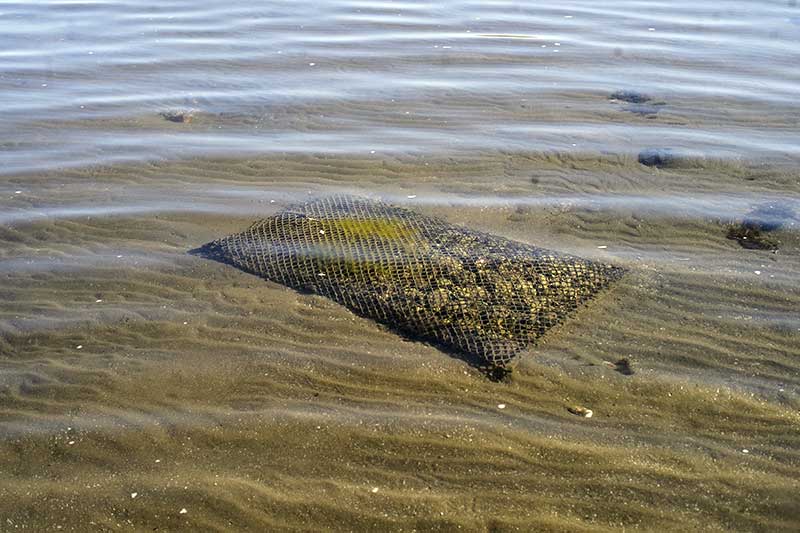
Oyster cultivation is one of Guardianas del Conchalito’s strategies for economic diversification and sustainability, developed in the waters of the estuary.
Photo: Eunice Adorno
It wasn’t all smooth sailing. To establish their cultivation area — more than 20 minutes from Nayarit Beach — they had to negotiate with OPRE, where some members opposed women occupying that space. “Yes, they put obstacles in our way, because where we are now belongs to OPRE. We had to hold an assembly with all the members to get permission,” Araceli recalls.
They also lacked their own boat, relying on relatives for transport. And the technical learning curve was steep. “When an oyster grew a small shell, we thought it was ruined. But in a sanitation course they told us it was just a tiny clam looking for a home — not harmful, the product was still good,” she laughs.
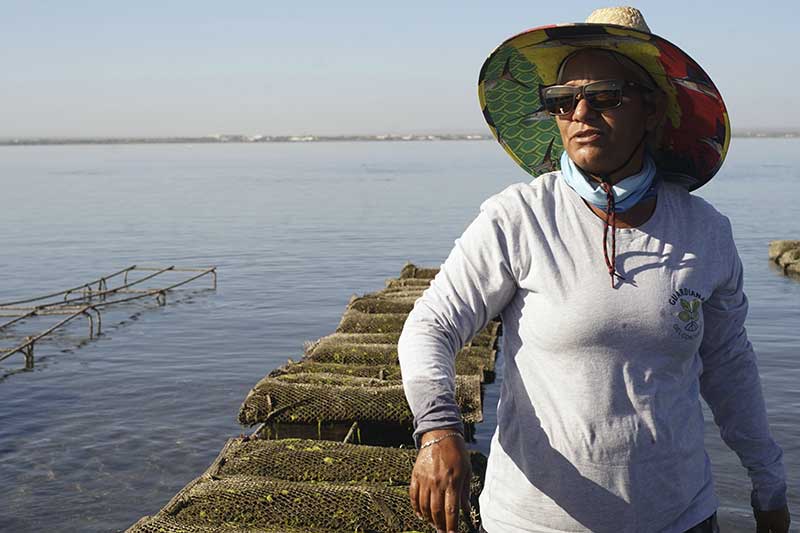
A member of Guardianas del Conchalito works on oyster cultivation—a project that initially sparked doubts within the collective. Today, after their first harvest in May 2024, it represents both economic diversification and autonomy.
Photo: Eunice Adorno
Production is still modest but growing. The Guardianas plan to reinvest their earnings in buying new spat and expanding cultivation. Their next goal: create a youth-run cultivation area — not for mass production, but to show visitors during tours. “We want people to see what we do, to get in the water with us, and to learn,” says Chelis.
Today, they no longer depend on borrowed spaces. After negotiations with Conanp and the fishing delegate, they secured an aquaculture permit right where they work. The concession now belongs to the Guardianas.
The Guardianas soon realized they couldn’t rely only on fishing or external aid. They had to diversify. In addition to oyster farming, they began cooking and selling fish tacos, drinks, and snacks at local events. Ecotourism became another source of income — not beaches and postcards, but mud, shovels, and open channels. Today, their tours include visits to the nursery, channel cleaning, and oyster tastings by the shore.
The logic is simple: more income sources mean less pressure on the sea.
Their role has also expanded to defending their territory. In the El Manglito neighborhood, they’ve faced projects that threatened the coast: a residential development seeking to privatize the beach with a private dock, and a boutique hotel that blocked access to a channel with fences. They didn’t remain silent. They attended assemblies, signed petitions, and lobbied until they regained access. In their words, the principle is clear: the sea cannot be privatized.
This learning also influenced their relationship with organizations. They acknowledge the importance of those who have supported them, such as Costa Salvaje, Mama Cash, and Fondo Semillas, among others, but they do not want to depend on them. Now they manage their own resources and decide how to invest them. "It's comfortable to depend on others, but it's not healthy. We want to be self-managed," Martha insists.
This independence is also reflected in their critical stance. They oppose projects they consider a setback, such as "Espíritu te necesita" (Espíritu Needs You). "Because it goes against the fishermen. For generations, they have harassed us with no-fishing zones, and now they want to disguise it in another way. No," Martha says firmly.

Amid the oyster fields, a Guardiana del Conchalito stands as a symbol of the resilience of the women who have overcome obstacles. Their work embodies autonomy and the promise of a sustainable future.
Photo: Eunice Adorno
She sums up their philosophy in one sentence: “Fishermen wither when they become employees. Freedom is what defines us.”
Their pursuit of autonomy has made them a community reference point. Neighbors turn to them for help with electricity bills, or with health and housing paperwork. Meetings with state authorities are held at Martha’s home. What began as surveillance became leadership.
“We live day to day, just making it to the end of the month. We never plan for the future. How can you imagine life 30 years from now? It makes no sense — as if you weren’t living,” Martha says.
For the Guardianas, time is measured in tides and oyster harvests — in channels that breathe again, in seedlings striving to grow. The rest will be left to those who come after them. What they do know is that their example is already taking root.
At the northern tip, fishermen like Alfonso Valenzuela are adopting ancestral and sustainable techniques to protect the vaquita—the planet’s most endangered cetacean— proving that conservation and a decent income can go hand in hand, despite market resistance and ongoing challenges.
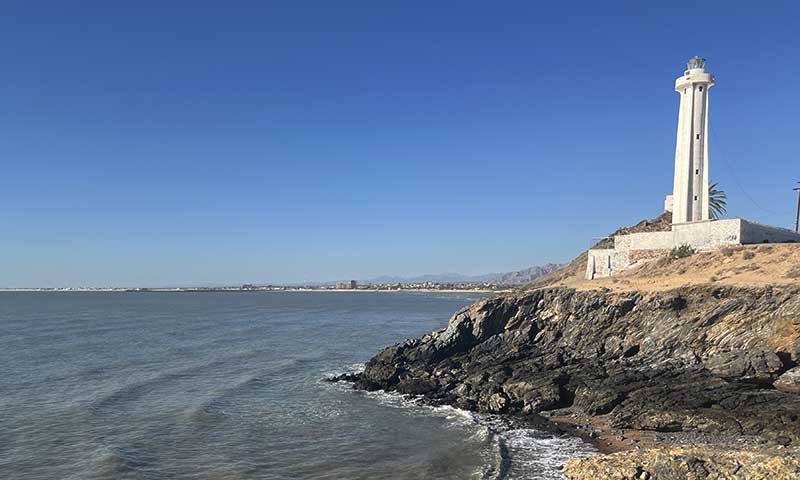
The coast of San Felipe stretches along the Upper Gulf of California, a meeting point between the desert and the sea. This region, rich in biodiversity and with a deep fishing tradition, currently faces the challenge of balancing development with the conservation of its fragile ecosystem.
Photo: Víctor R. Rodríguez
By Víctor R. Rodríguez
A hot wind blows from the jaws of the Baja Californian desert, heralding a relentless, crushing summer. Alfonso Valenzuela – Poncho to everyone – prepares to go fishing in San Felipe, a port nestled in the Upper Gulf of California. He won't use nets. He decided to return to the old method —line and hook —so as not to entangle the vaquita, the planet's most endangered cetacean. If the sea is on his side, he will return with just enough for a dignified income.
"When we first arrived here, there was abundance, there was everything. But little by little, it’s become scarce because of all the nets in the water,” Poncho says, his gaze fixed on the sea that has watched him grow old.
Nets promise more volume, but piles of fish don’t always mean more income. With line and hook, the story changes: the volume drops, but every kilo of Gulf corvina —a species found only in this corner of the world— fetches a better price. Poncho chose this path when he joined a sustainable fishing program for conservation purposes, launched in 2022 by the organizations Pesca ABC and Pronatura Noroeste. There, he learned techniques like Ike Jime, a Japanese method that preserves fish quality and boosts its market value.
This shift has placed Poncho and other fishermen at the heart of an unavoidable tension. In the Upper Gulf of California, the livelihood of hundreds of families coexists with the urgent need to protect species on the brink of extinction. To go fishing here is to walk a tightrope —to survive without compromising the future.
The Upper Gulf of California is one of Mexico’s most productive fishing regions. According to the Mexican Institute for Research in Sustainable Fisheries and Aquaculture (IMIPAS), the main fisheries include Gulf corvina, caught from March to October; chano and sierra in April; and traditional shrimp fishing between September and November. Together, these fisheries generate around 72.4 million pesos each year.
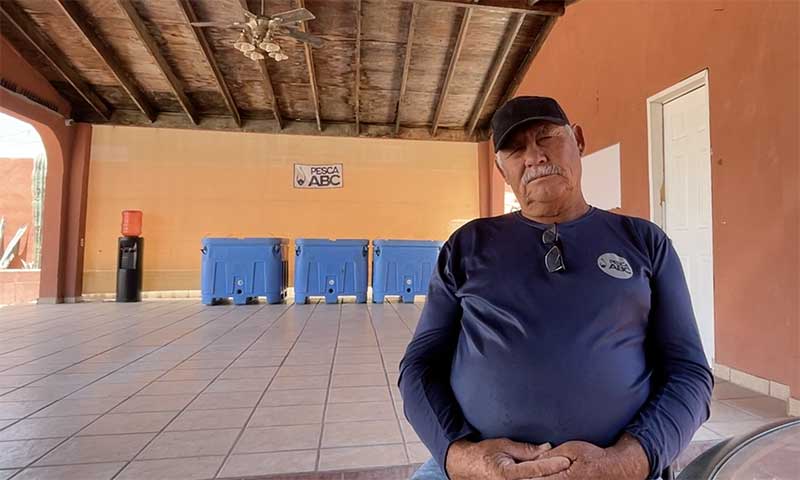
Interview with Alfonso Valenzuela, a fisherman from San Felipe, who shares his experience and commitment to sustainable fishing techniques in the Upper Gulf of California.
Photo: Víctor R. Rodríguez
Alongside its productivity, the Upper Gulf is also one of Mexico’s most monitored and regulated seas. Here, conservation happens at the edge of possibility: traditional fisheries share the same waters as the vaquita, Mexico’s most vulnerable marine mammal. Scientific monitoring that began in 1997 paints a stark picture: from 567 vaquitas in the 1990s, the population fell to just nine in 2018—a 95% decline. The most recent estimate, from 2024, suggests that only six to eight specimens remain in these waters.
Bound by constitutional duty and international pressure, the Mexican government has been striving for years to transition toward fishing gear that doesn’t doom the porpoise to extinction. It’s an uphill process, but one with a clear horizon: the creation of a Marine Prosperity Area.
Poncho doesn’t sail alone. Beside him is 60-year-old José Ernesto Martínez—known as Malacara—another San Felipe fisherman who also joined the sustainable fishing program, which currently includes only 20 participants.
Malacara casts his line and waits. Patience is part of the trade. Suddenly, a pull—there’s movement on the other end. With a confident motion, he lifts the fish from the water and passes it to Poncho. Poncho takes his knife and, with a precise thrust, ends its life swiftly and cleanly, just as the Ike Jime technique prescribes.
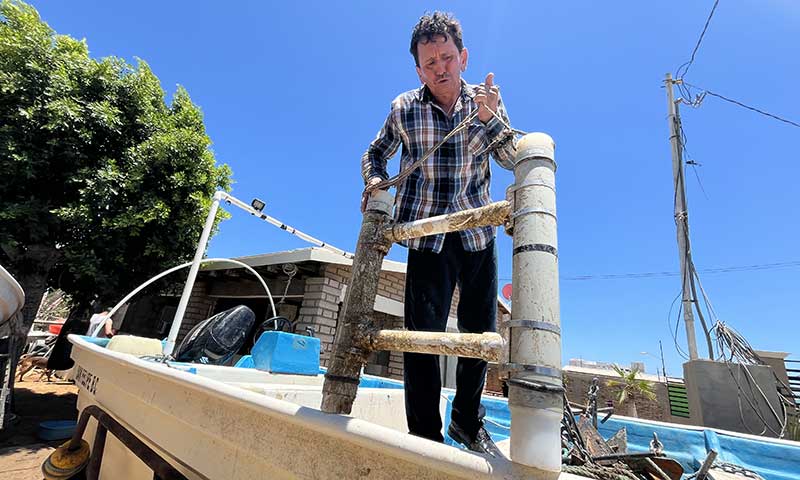
A fisherman checks his C-POD (Cetacean Detector) equipment aboard his vessel in the Upper Gulf of California. These acoustic devices are crucial for monitoring the vaquita and other marine species.
Photo: Víctor R. Rodríguez
The sustainable fishing program, funded by international sources, was launched in 2022 with one basic principle: stay close to the community. Listen, and let fishermen envision their own future—how to fish differently, and how to make conservation more than a political or scientific slogan. This collective effort, this co-design, forms the first pillar of the Marine Prosperity Area (MPpAs): community participation.
Training soon became central. For the first time, fishermen saw themselves not as recipients of orders but as part of the strategy. Workshops, meetings, and hands-on practice in new techniques contributed to the second pillar: capacity building. Training stopped being a promise and became a daily practice.
Progress also relies on private initiative. El Sargazo, a seafood company based in Ensenada, Baja California, rewards sustainability by paying up to 3.2 times more per kilo when the fish carries the traceability mark, the hook, and the Ike Jime seal. Less volume, yes—but greater value.
“As long as there is demand for products caught with hooks, processed with Ike Jime, and carrying traceability, more pangas will join the effort in the Upper Gulf,” says Pesca ABC's science coordinator for fisheries, Georgina Proal.
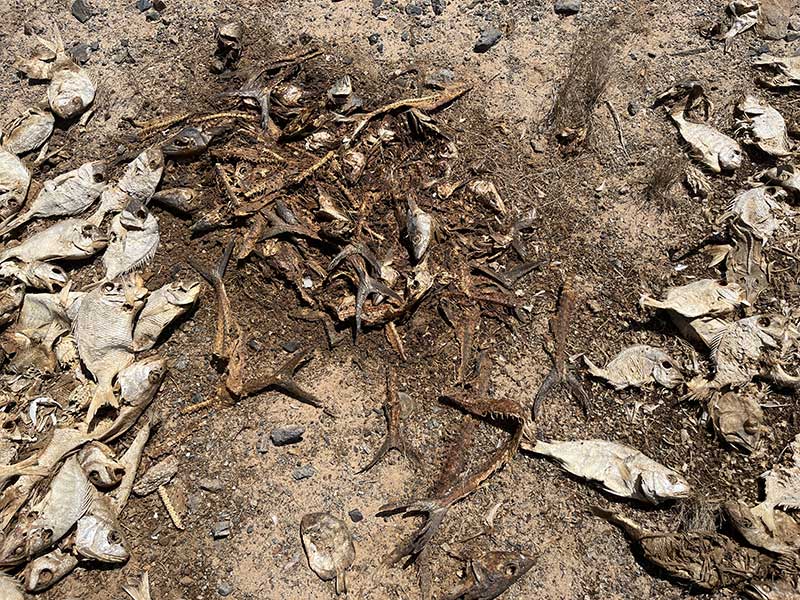
The harsh reality of an illegal fishing dump, where dried and dead fish highlight the devastating impact of illegal practices on marine resources and ecosystem health.
Photo: Víctor R. Rodríguez
Poncho and Malacara know this well. They don't just fish; they are also part of the network that seeks to save the vaquita. Supported by scientists, local fishermen set sail and, guided by GPS coordinates, deploy hydrophones to collect data and clearly delineate the vaquita's proper habitat. These mapped data allow experts and the Mexican government to adjust the species' conservation strategy.
With hydrophones in the water and El Sargazo rewarding traceable catches, glimpses of the MPpAs’s third pillar—monitoring and co-management—begin to emerge. But it’s still just a sketch. A formal governance system, sustainable infrastructure, and broader community participation are still needed. For now, what exists are the first signs of a potential Marine Prosperity Area.
Earning more by fishing without nets and supporting conservation sounds like the perfect formula. But the reality is different: Poncho and Malacara are exceptions. Only 20 men participate in this program, out of a registry of 1,738 active fishermen in San Felipe, Baja California, as of 2024, according to the National Commission of Aquaculture and Fisheries (Conapesca). The numbers speak for themselves.
The market for fish caught with sustainable techniques, for now, remains stagnant. Two out of twenty, twenty out of thousands—a drop in the ocean.
In San Felipe, 1,738 people make their living from fishing, yet only about twenty have adopted sustainable techniques. The market for such products remains limited, and orders are scarce, discouraging other fishermen from joining the conservation effort in the Upper Gulf of California. The slowdown isn’t up to them or their partner organizations—but it affects both their wallets and their morale. “The product is here,” says Poncho. “It’s just a matter of getting it into the markets.”
In summer, legal fishing goes on pause. Fishermen call this period el piojo—“the louse”—months of waiting and resisting until the next season. Like Poncho, those enrolled in the sustainable fishing program remain steadfast, convinced that fishing differently is the way to recover the sea of abundance they once knew.

While fishermen like Poncho endure "the louse" (piojo) of the closed season with sustainable gear, this illegal net dump in the Upper Gulf starkly contrasts with their vision of an abundant sea, serving as a reminder of persistent threats and the urgent need for responsible fishing.
Photo: Víctor R. Rodríguez
After the devastation caused by Hurricane Roslyn, the Nayarit community of Boca del Camichín is rising again, guided by the strength of the Marismas Nacionales and the San Pedro River, forging a model of sustainable development and collective resilience. For its people, defending the ecosystem is defending their own lives.
By Raquel Zapién Osuna
En octubre de 2022, el huracán Roslyn puso a prueba la capacidad de resistencia y adaptación de la comunidad de Boca del Camichín. De las 500 balsas flotantes utilizadas para el cultivo de ostiones entre los manglares y las lagunas costeras de las Marismas Nacionales de Nayarit, no quedó casi nada. La magnitud de la pérdida fue devastadora, pero la respuesta comunitaria demostró una resiliencia ejemplar.
In October 2022, Hurricane Roslyn tested the resilience and adaptability of the Boca del Camichín community. Of the 500 floating rafts used for oyster cultivation among the mangroves and coastal lagoons of Nayarit's Marismas Nacionales, almost nothing remained. The magnitude of the loss was devastating, but the community's response demonstrated exemplary resilience.
Three years later, the landscape has changed: 430 artisanal wooden rafts once again float on the water, safeguarding this year's oyster production thanks to the collective effort of the 163 members of the Ostricamichin Cooperative, including nearly 40 women.

In the coastal landscape of Boca del Camichín, a fishing boat and oyster shells reflect the community's oyster farming activities. This environment, part of the Marismas Nacionales and fed by the San Pedro River, is fundamental for the sustainable development and resilience of its inhabitants.
Photo: Cruz Morales
In October 2025, the community took another step forward by establishing its first community risk management brigade. The initiative promotes a culture of prevention against future storms and hurricanes—events that are expected to become more frequent and intense as the climate crisis deepens. This proactive approach is crucial in such a vulnerable region and sets an important precedent for other coastal communities.
But meteorological phenomena have not been the only challenge for this coastal town in the municipality of Santiago Ixcuintla, Nayarit. Here, people have had to organize to maintain their primary source of income, which involves protecting the mangrove forests and the San Pedro Mezquital River basin, the last free-flowing river in the Sierra Madre Occidental. Its fresh waters keep the marshes alive—an ecosystem vital to Mexico’s Pacific coast.
This community's story of resilience has deep roots. In the 1970s, when oyster beds collapsed due to overexploitation, the General and Aquaculture Fishing Production Cooperative Society Ostricamichin was formed as part of a federal government program. Fishermen, initially skeptical, eventually joined when they saw that wild production was no longer sufficient, recalls Óscar Guadalupe Padilla Angulo, president of the cooperative and son of Eleuterio Padilla Tapia, a founding member. This turning point is key to understanding the community's transformation towards sustainable management.
Today, in Estero Grande, Boca del Camichín—where river and sea converge—production reaches between 800 and 1,000 tons per year. Most oysters are sent to Guadalajara before being distributed to other parts of the region.
Cultivating the native oyster (Crassostrea corteziensis) provides work for eight months of the year, while shrimp, scale fish, shark, and prawn fishing supplement the income of this community of over 1,300 inhabitants.
“Many of us no longer fish full time; we focus on harvesting and maintaining the oyster beds,” says the cooperative leader. “Few dedicate themselves entirely to fishing, but the impact on fisheries is minimal.”
Nearly everyone in the community is linked to oyster farming or related activities—preparing cultivation ropes, collecting, packing, or selling. Women, children, youth, and elders from the famous "oyster capital" participate in these processes.
“It’s a family endeavor; children start helping with the ropes from a very young age,” explains Heidy Zaith Orozco Fernández, executive director of the Center for Social Development and Sustainability Nuiwari, a civil association that has supported the community in defending its territory and strengthening its organization.
This biocultural bond with nature has made Boca del Camichín one of the main bastions in the defense of the river and the marshes—where ecological restoration has gone hand in hand with social and economic development.
The most emblematic struggle was against the Las Cruces hydroelectric project, promoted by the Federal Electricity Commission (CFE), whose Environmental Impact Statement was authorized by the Ministry of Environment and Natural Resources in 2014. This conflict is a paradigmatic example of the tension between economic development and environmental conservation in Mexico.
Protests by citizen organizations, fishing and rural communities, and the Náayeri and Wixárika indigenous peoples temporarily halted the project. And although studies demonstrating its unviability have been presented, the threat persists because the plan has not been discarded and is intended to be resumed under the name of Presa del Nayar.

A native oyster (Crassostrea corteziensis) in the foreground — a cornerstone species for the sustenance of Boca del Camichín. Its cultivation is vital to the Ostricamichín Cooperative, which has built a model of adaptation and resilience within Nayarit’s coastal ecosystem.
Photo: Cruz Morales
The Ostricamichín cooperative remains on alert. Its members attend informational meetings promoting the project and participate actively in public consultations.
“Every time they call a consultation, we go to defend ourselves and make it clear that we disagree,” says Óscar Padilla.
In Boca del Camichín, there is a collective will. “It’s something essential,” Padilla adds. “We must take care of our environment—it’s where we live, what feeds us, what lets us survive. And besides, it’s a wonderful place.”
The community has forged alliances to strengthen its capacities and leadership. The Nuiwari civil association has been key in this process. It emerged during the defense of the San Pedro River and, although initially focused on defense, today its strategies are aimed at strengthening community structures to face their difficulties, explains Heidy Orozco.
One of the most recent achievements was the formalization, in October, of the first community risk management brigade, which will develop an action plan outlining what to do before, during, and after the arrival of a hydrometeorological phenomenon. The formation of this brigade is a concrete step towards community autonomy and self-management in emergencies.

Ostricultores de Boca del Camichín cosechan en Estero Grande, donde la mezcla de agua dulce del río San Pedro y salada del mar crea un entorno óptimo. Esta labor, esencial para la economía local, es un pilar de la gestión sostenible en las Marismas Nacionales.
Photo: Cruz Morales
At the request of local women, the community has also begun preventive work with children to reduce the risk of future addictions. Their first step was to form the children’s club Los Ostiones (“The Oysters”), where kids learn about their rights, the environment, and how to prepare emergency backpacks.
Another strategic project is the inclusion and recognition of women in the fishing sector. Empowering women and children is essential for the long-term sustainability of the community’s project.
As part of that effort, in April 2025, the women of Boca del Camichín hosted the First Meeting of Riverine and Sea Women, welcoming fisherwomen from across northwest Mexico to reflect on women’s often-unpaid and unacknowledged role in the value chain. On October 11, they hosted another gathering that led to the creation of the Network of Riverine and Sea Women of Nayarit.
The establishment of this network represents a significant advance in the visibility and recognition of women's work in the regional fishing sector. According to recent research by Xavier Basurto, published in Nature, four out of ten fishers worldwide are women. They can be part of the family business—wives, mothers, daughters—or simply women from the community hired to do the work. Currently, with the support of WWF and Nuiwari, efforts are being made to strengthen the cooperative's processes and promote the inclusion of women.

Children in Boca del Camichín take part in workshops organized by Los Ostiones (“The Oysters”) club, promoting environmental awareness and knowledge of their rights. The initiative aims to empower new generations to protect and care for their natural surroundings, including the Marismas Nacionales and the San Pedro River.
Photo: Cruz Morales
All these actions complement the ongoing surveillance, cleanup, and conservation work carried out by local families in coordination with the National Commission of Natural Protected Areas (Conanp), which manages the Marismas Nacionales Nayarit Biosphere Reserve. This protected area covers 133,854 hectares and contains nearly 20% of Mexico’s mangroves, making it a Ramsar wetland of global significance across five municipalities. Its protection is essential for biodiversity and climate mitigation.
Meanwhile, life in Boca del Camichín flows between the oysters cultivated in the marshes and those served to visitors—fresh, in tamales, soups, or empanadas—who come to savor the place’s cuisine and ecotourism activities.

An oyster farmer from the Ostricamichín Cooperative explains the cultivation process in Boca del Camichín. Their expertise preserves artisanal techniques and a deep connection to an activity that has enabled the community to rebuild and adapt to change, keeping its oyster-farming tradition alive.
Photo: Cruz Morales
The Ostricamichín Cooperative hopes to establish an oyster-smoking plant to add value to their production and create jobs for young people. The project was close to becoming a reality when Hurricane Roslyn struck, destroying more than 90% of the harvest and damaging facilities, forcing a halt. Its eventual completion could become a key economic engine, diversifying income and ensuring the participation of new generations.
To recover, the cooperative members returned to artisanal fishing, restarted cultivation, and began rebuilding with their own savings after funds ran out.
"We thought we wouldn't recover," recalls the cooperative's president. But they did.
A community of fewer than 700 inhabitants has established a model of conservation and prosperity by integrating artisanal fishing with vibrant ecotourism —where protecting iconic species such as the whale shark translates into both income and a profound connection with nature.
By Víctor R. Rodriguez
More than 900 kilometers south, along the same coastline, lies Bahía de los Ángeles, Baja California—a place where the rhythm of life feels different. Another spirit moves through its shores and within its people.
Nestled within the Bahía de los Ángeles, Canales de Ballenas y Salsipuedes Biosphere Reserve, this protected natural area spans over 380,000 hectares. It shelters species such as the green sea turtle (Chelonia mydas), loggerhead turtle (Caretta caretta), olive ridley (Lepidochelys olivacea), whale shark (Rhincodon typus), and fin whale (Balaenoptera physalus), as well as 911 species of fish.

Residents and visitors gaze out over the vast expanse of Bahía de los Ángeles. In this natural sanctuary of Baja California, the community has forged a model where artisanal fishing and ecotourism intertwine with conservation—working toward a future of shared prosperity with the sea.
Courtesy: Vermillion Sea Institute
This mosaic of life has allowed the small community—fewer than 700 people, according to the 2020 census—to organize around the conservation of its natural environment. It wasn’t always like this. In the 1950s, fisheries for species such as totoaba, shark, and grouper reached their highest catches, while during the 1960s, Bahía de los Ángeles recorded the largest marine turtle fishing in Mexico. That changed in 1990, when all sea turtle species were granted full protection under Mexican law and their trade was banned. Like the tides, change arrived suddenly—and transformed everything.
Unlike San Felipe, in Bahía de los Ángeles the foundation of community participation within a Marine Prosperity Area began in the earliest stages of establishing the protected zone. It was the residents themselves who sought government support and determined the level of protection their territory required.
Today, most of the town’s people make their living from artisanal fishing or from tourism-related activities, ranging from ecotourism to sportfishing—an activity that has grown rapidly in recent years.
The seasonal arrival of sea turtles and the whale shark, protected under NOM-059, has motivated locals to undergo training and certification to provide safe, regulated tours that allow visitors to observe these species responsibly. The combination of fishing and tourism sustains the community, both economically and socially. They run and monitor the activities themselves—an essential level of participation for any Marine Prosperity Area to endure and to foster marine ecosystem recovery.

A young girl examines nature through a magnifying glass in Bahía de los Ángeles. Here, curiosity for science and conservation is nurtured from an early age, preparing new generations to become guardians of the rich marine biodiversity that surrounds them.
Courtesy: Vermillion Sea Institute
With the sunburned skin of someone who works outdoors every day, Meghan McDonald—biologist and director of the Vermilion Sea Institute—smiles easily, framed by the sea and its majestic islands through her window. The American scientist speaks enthusiastically of a united community, of young people actively engaged in citizen science, eager to learn, and determined to keep their town clean and nature alive. She speaks of opportunities, without ignoring the challenges.
“For people to be from here, to want to stay here and work to support their families—that’s the only way it can be sustainable, both for them and the environment,” says McDonald, referring to the community’s challenge of promoting conservation without losing income. The whale shark, whose season runs from July to October, represents a vital source of income for local tour operators, who can earn up to USD 250 for a four-hour sighting tour.
But the problem begins when the whale sharks leave—and the visitors with them. The isolation that makes Bahía de los Ángeles so pristine and appealing also limits tourism, putting pressure on family incomes once the season ends.
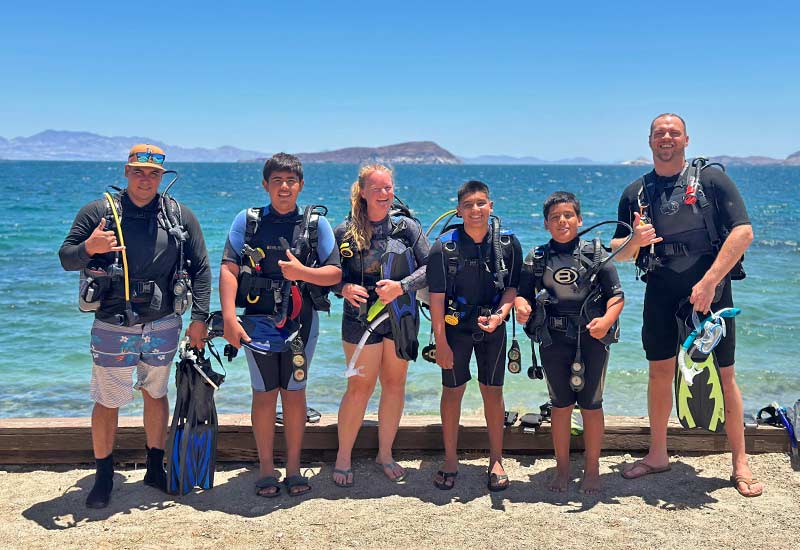
A group of young divers prepares to descend into the waters of Bahía de los Ángeles. With their gear ready and excitement in the air, these future guardians of the sea represent a new generation that, through exploration and citizen science, advances conservation and ecotourism in the region.
Courtesy: Vermillion Sea Institute
McDonald speaks of broadening the scope of tourism by embracing the region’s geology, the arrival of migratory birds, the nearby mangrove ecosystems, and even sailing—an increasingly popular activity that requires nothing more than the landscape itself.
When 80% of the community of Bahía de los Ángeles is dedicated to tourism and depends on the sea, widespread participation is notable —a level of cooperation that breathes life into coastal and marine conservation efforts. In such a small town, communication is fast; even Facebook groups sometimes help.
The reality is that the community remains peaceful, full of possibilities. "Here I see people who are passionate about their community, about nature. More now than in the past," comments the biologist who feels entirely local. "What excites me a lot is how quickly we can make changes in our community, because we’re all connected."
Bahía de los Ángeles, Canales de Ballenas y Salsipuedes, is a protected natural area with a surface area exceeding 380,000 hectares. It serves as a habitat for species such as the green sea turtle (Chelonia mydas), loggerhead sea turtle (Caretta caretta), olive ridley sea turtle (Lepidochelys olivacea), hawksbill sea turtle (Eretmochelys imbricata), whale shark (Rhincodon typus), common fin whale (Balaenoptera physalus), in addition to 911 species of commercially valuable fish.
INTERVIEW with Meghan McDonald, Coordinator of the Vermillion Sea Institute organization.
Tell me about Bahía de los Ángeles. What makes it so special?
It’s an ecologically unique place. There are 16 islands and, just off the coast, deep waters shaped by the San Andreas Fault. This combination creates a marine system incredibly rich in nutrients—the foundation for fish, marine mammals, sharks, and turtles.
What are the most representative marine species in the area?
Definitely the whale shark, whose season begins in July. Most of the specimens we receive come from La Paz, Baja California Sur. We also receive gray, blue, humpback, fin, and minke whales—and occasionally orcas. Dolphins and sea turtles are common as well.
What do most residents of Bahía de los Ángeles do for a living?
Fishing remains the main economic activity, followed by ecotourism. In recent years, sport fishing and nature tourism have grown.
Have you noticed changes in the abundance or size of fish?
Yes. Although we still see large specimens, their size has decreased compared to when I was a child. The current average is 10% smaller than before.
What are the main challenges for the marine ecosystem?
The biggest challenge is ensuring that local families can make a living sustainably. We must respect catch limits so as not to jeopardize the community’s future.
What community initiatives promote environmental care?
There are several. One is Aventureros, a youth program that combines environmental education, research, and water sports. They’ve organized beach cleanups, monitored microplastics, and encouraged local restaurants to replace Styrofoam with cardboard. Another is María Viva, which recycles single-use plastics into keychains, fences, and furniture.
Who participates in these efforts?
Mostly young people, but also women and entire families. For instance, the Mujeres con Alas group collaborates on education and craft projects.
How broad is community participation?
Bahía de los Ángeles has about 1,000 residents. We estimate that 70–80% have taken part in at least one community activity over the past year—from ecological fairs to whale shark monitoring.
How do you make collective decisions?
We use Facebook groups a lot, though word of mouth is still significant. In a small town, news spreads quickly.
Do you think the Marine Prosperity Area model can be applied here?
Yes—but only if protection comes from the community itself. Unlike elsewhere, we were the ones who asked the federal government to establish the protected area. That experience taught us that local governance is essential for the model to succeed and for people’s real needs to be respected.
Facing depleted seas and overexploitation, a young fisherman from a traditional shark-hunting community proposes a bold shift: harnessing his region’s underwater wealth—like the silky shark—to generate income without extraction, forging a model for a Marine Prosperity Area.
By Aminetth Sánchez
Alejandro Lucero rides in the passenger seat with a steaming cup of coffee in his hands. It’s not in a thermos or a lidded mug, but an open cup, filled to the brim. The liquid trembles with every dip and rise of the dirt road, yet he seems unfazed—by either the jolts or the thermometer reading over 30 degrees Celsius. Locals say a true aguamargueño drinks hot coffee at any time of day and never spills a drop. The truck drives out of Agua Amarga, a small town in Baja California Sur, toward Ensenada de los Muertos, a blue port: blue sea, blue sky, blue the line that joins them. That’s where the fishermen gather.
Agua Amarga, the community where Alejandro grew up, has always lived off the sea. Its fishermen—mostly shark hunters—set out at dawn in their pangas, venturing toward three traditional fishing grounds: Punta Arena, Cueva de León, and Ensenada de los Muertos itself. Each spot had its season, its tides, its secrets passed from fathers to sons. For them, fishing is not merely a trade; it’s an identity. “People here are fifty percent person and fifty percent fisherman,” the 28-year-old says, laughing. They know how to read the sea, decipher currents, and recognize the invisible signals that others can’t.
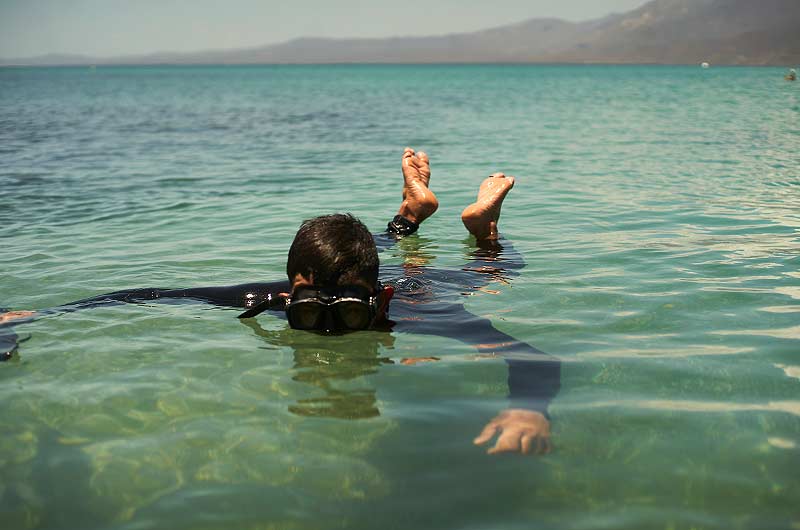
Alejandro Lucero snorkels in the clear waters of Agua Amarga. For this young fisherman from Baja California Sur, the sea is not only his home but also the canvas of his vision: to show that his community’s true wealth lies in the marine life that can be observed and protected.
Photo: Eunice Adorno
For years, life in this town of some 600 inhabitants revolved around the sea: family calendars followed the sharks’ movements, engines obeyed the moon, and collective memory was built on whatever the water yielded. Until the situation could no longer be sustained.
“Fishing is no longer enough.” That phrase echoes through Agua Amarga’s homes. Overexploitation, industrial tuna fleets—often illegal—falling market prices, increasingly empty seas, and the threat of real estate development have changed everything. And not just here: the UN Food and Agriculture Organization (FAO) estimates that 35.5% of the world’s fish stocks are overexploited. “Fishing doesn’t pay anymore. You have to go farther and farther, and you catch less and less, especially scale fish. And shark fin prices keep dropping,” Alejandro says.
The sea that sustained them for decades no longer guarantees a livelihood. Younger generations leave for work in the city—La Paz or even farther away. Alejandro Lucero decided to take a different view. The son of a fishing family, he studied alternative tourism and became convinced that Agua Amarga’s wealth no longer lies in what can be taken from the sea, but in what can be shown from it. “A shark is worth more alive than dead,” he says. That phrase—his mantra—captures his vision: to help transform the local economy through sustainable tourism and marine wildlife encounters. Others have tried similar efforts, but his proposal is different: it begins and stays within the community.
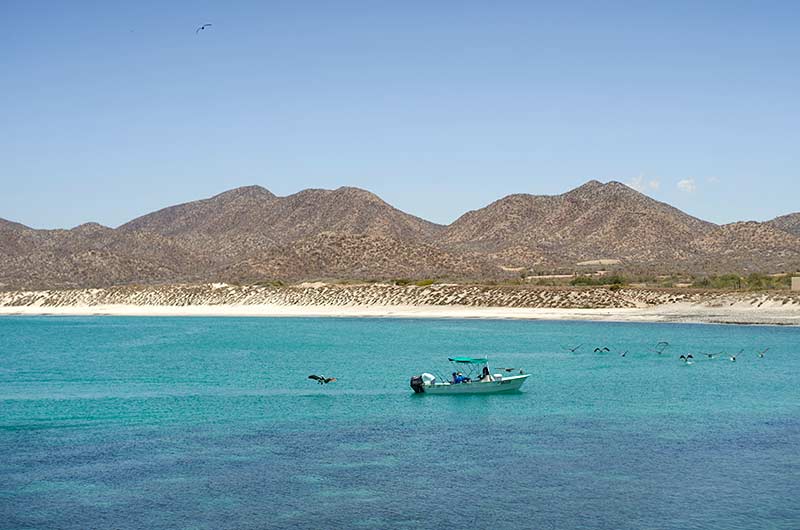
A panoramic view of Agua Amarga Bay reveals its blue waters and clear skies. This corner of Baja California Sur, historically rooted in fishing, now looks towards the horizon of sustainable tourism, seeking new ways to prosper in harmony with its vast marine richness.
Photo: Eunice Adorno
This is not about creating an untouchable sanctuary or a “paper park,” like some of the forty Marine Protected Areas that appeared on maps after 1996 but rarely in reality. Instead, it’s about a model where marine protection goes hand in hand with people’s livelihoods.
“I’m promoting more economic alternatives like tourism, wildlife viewing, snorkeling—all within a legal framework. Using the area as a tourist destination, but responsibly,” Alejandro explains. The logic is simple: it’s not about closing the sea, but about opening opportunities.
Caring for sharks, manta rays, and reefs translates into immediate income, local jobs, and shared pride—rather than waiting years for the ocean to recover.
That certainty wasn’t born in classrooms or books, but underwater. Alejandro remembers his first real encounter with the marine world: diving with a speargun, one of those that shoots a metal rod, known locally as a harpoon. As he improvised his routes through the depths, he met an eagle ray—its triangular head dotted in white, its tail long and sinuous. “I didn’t know them; I didn’t know what it was,” he recalls. From that moment, he understood that the sea held treasures far more valuable alive than dead.
But along with wonders, he also discovered absences—species he never saw, known only from his elders’ stories: the oceanic whitetip shark, the hammerhead, the leatherback turtle. In that blend of memory and loss, the spark for his project was born. He realized it wasn’t enough to take them out of the water; they had to be shown.

Family photographs on the wall of Alejandro Lucero's home evoke Agua Amarga's deep fishing tradition. These images bear witness to generations dedicated to the sea, a heritage that Alejandro seeks to transform towards conservation and sustainable tourism.
Photo: Eunice Adorno
Today, that idea is taking shape. “I’m starting to work with fishermen to create a tourism product—so they can be trained and offer the service,” he explains, as visitors snorkel among pufferfish nearby. The response has been positive: there’s interest in diversifying, and more and more locals are turning to tourism as an alternative. Across the region, sportfishing and wildlife-viewing tours already exist, but often in isolation. Alejandro aims to weave them into an organized, community-based economy instead of leaving them as scattered ventures.
On that horizon, he envisions a community diving center within five years. He calls it Comunidad Mar (Comar), designed to train fishermen and launch tourist routes that recover Agua Amarga’s shark-fishing legacy. One idea: the “Shark Fishermen’s Route,” a tour that retraces, in a new key, the journeys his parents and grandparents once made—now to tell a different story.
Alejandro Lucero Lucero, father of the young fisherman, has spent more than forty years at sea. Since he was ten, he would join his father and grandfather to fish for hammerhead sharks. He is the fourth generation in a line of fishermen, and although his hands still bear the mark of the trade, his eyes reflect the ocean’s changes.
He remembers when giant manta rays used to glide like shadows beneath the pangas, and how, over the years, they vanished. Now, he says, they are starting to return—and that gives him hope. “People are beginning to understand that we need to take care of it,” he says, his voice vibrating with emotion as he speaks of the sea, of mobulas, of turtles, of fish.
In Agua Amarga, some fishermen are finding new ways to live from the sea—guiding sportfishing trips, wildlife tours, or simply taking visitors to experience its beauty without removing a single creature from the water.
He himself encourages the more hesitant fishermen to see things differently: it’s no longer just about fishing—it’s about thinking ahead, about what our children will inherit. Extraction without care no longer works.
Alejandro Sr. says he feels proud to see his son nurturing a new mindset within the community. He recalls that the younger Alejandro was never one to enjoy fishing much: “He’d dive to take photos, to watch the animals—he always saw things differently.”
“We’re starting to see the same species my grandparents used to fish,” he says proudly. For him, real change doesn’t come from laws or projects, but from the awareness slowly taking root among his people—the understanding that what defines them must also be protected: they are, above all, people of the sea.
Alejandro’s proposal is ambitious. He has studied models from other countries where shark tourism became an economic engine. In the Bahamas, for instance, hammerhead shark diving generates about $100 million a year. In the Philippines, entire communities shifted from hunting thresher sharks to protecting them—because tourism paid better. “Up to 35,000 divers come looking for the shark,” he says.
These examples convince him that the sea can indeed be worth more alive than dead—so long as the benefits remain in the community’s hands. And in this corner of Baja California Sur, which species holds the most promise? Alejandro doesn’t hesitate: the silky shark. “The closed season is starting now, and they’re everywhere. We have the same as the Bahamas or the Philippines: clear waters, abundant marine life, and a privileged location. We just need to organize it,” he insists.
Today, if a fisherman catches a silky shark, he might sell it for 1,000 to 2,000 pesos. But leaving it in the sea opens another possibility: a tourist outing to see it alive can bring in around 8,000 pesos per boat, with five or six passengers aboard. Three days of sightings can mean up to 18,000 pesos—and the shark stays in the water. Around that experience, guides, lodging, restaurants, and transport services can thrive—an entire economy anchored to keeping the shark alive.
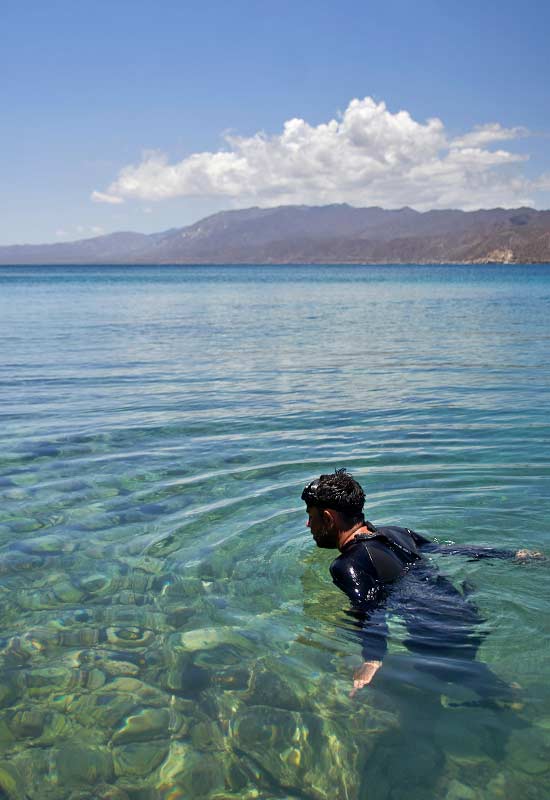
Alejandro Lucero, in his element, immersed in the sea. His passion for discovering and documenting marine life, especially new or little-known species, was born from diving in these waters. Each immersion is a lesson and reaffirms his conviction that Agua Amarga's true treasure is alive beneath the water.
Photo: Eunice Adorno
The plan sounds simple but faces resistance. Many Agua Amarga fishermen eye with suspicion the idea of abandoning the trade their parents and grandparents handed down. Others fear that turning the area into a recovery zone will exclude them from the sea. The mistrust is understandable: they’ve lived for decades at the mercy of what the ocean decides to give. But Alejandro insists it’s not about forbidding—it’s about opening new paths. He envisions fishermen becoming snorkeling guides, boat operators, or diving instructors—transforming their sea knowledge into a different kind of expertise, without losing who they are.
He estimates that about half of the community’s fishermen are now involved in tourism, and the rest are on their way. They know fishing no longer sustains them and are looking to tourist pangas instead. The obstacle is cost: equipping a boat for visitors can run up to 800,000 pesos—a steep investment for families who barely survive on what the sea provides.
“In two or three years, I imagine the region living entirely from tourism, with people valuing our flagship species,” he says. What could stall that, he warns, are laws that pull in opposite directions: some, like Mexico’s Official Standards (NOMs), allow unlimited extraction; others, like the General Law of Ecological Balance and Environmental Protection, prohibit all use. “Right now, they’re not coherent. One law says, ‘Take the fish’s eye out, do whatever you want.’ And another says, ‘No, don’t touch it.’”
For Alejandro, the sea has always been everything. In that cup of coffee, that certainty remains: even if the road is rough and the future uncertain, what matters must be held firmly—without spilling a drop. Agua Amarga stands before a choice: keep squeezing an exhausted ocean, or reinvent itself alongside it.
After decades of overexploitation and neglect, fishermen from a coastal neighborhood in La Paz, Baja California Sur, decided to stop, clean, and restore the waters where they grew up. Today, their collective effort is beginning to pay off—in returns from the sea.
By Aminetth Sánchez
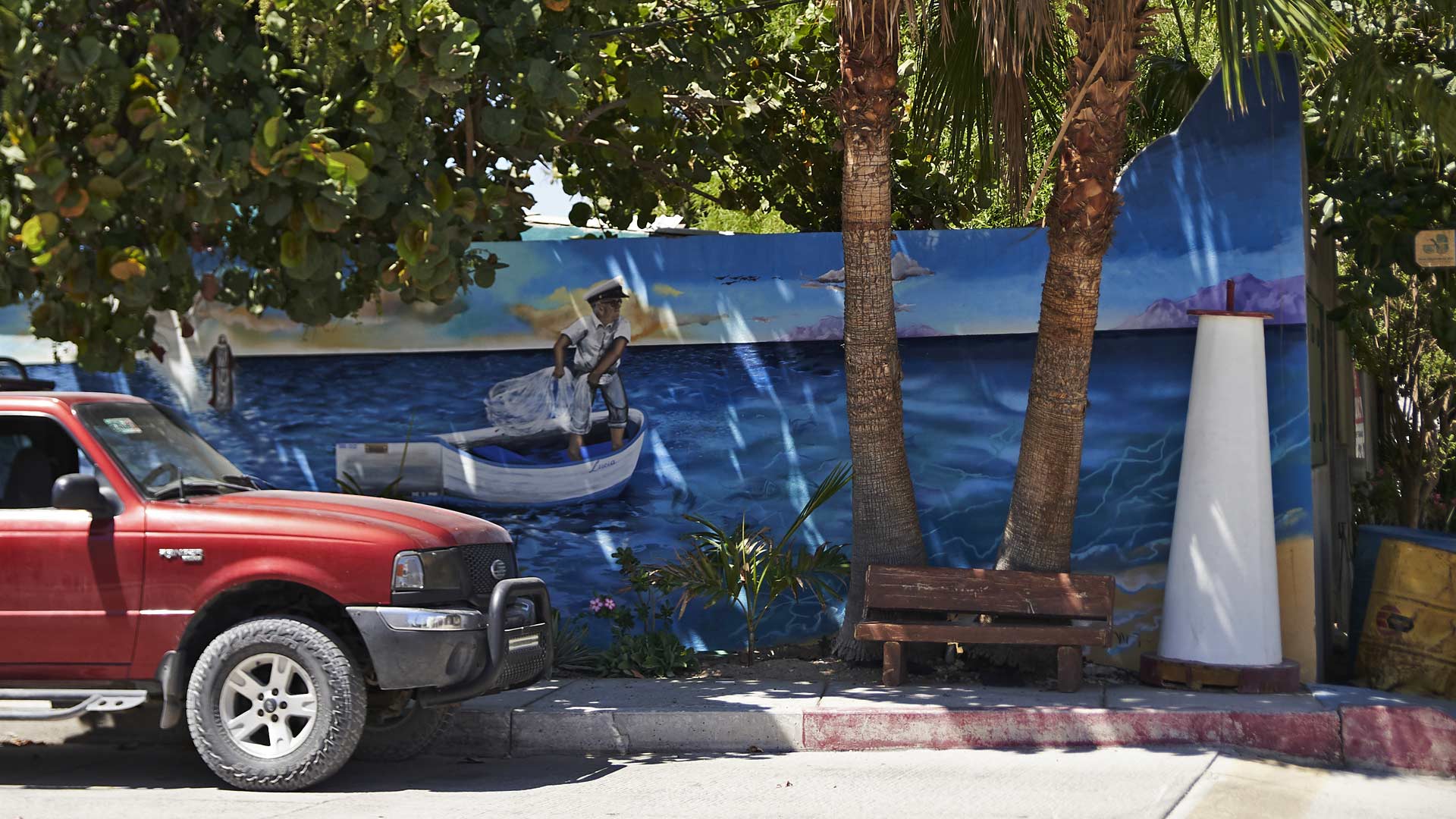
Hubert Méndez was nine years old when he first rode out in a panga with his father, a fisherman. The man dove into the sea, disappeared beneath the surface, and when he returned, he told his son what he’d seen: a paradise. He spoke of the Ensenada de La Paz, on the southeastern coast of the Baja California Peninsula, as a place of beauty, where scallops, catarina clams, and seaweed formed an underwater garden. It was the early 1960s. The boy listened intently, storing those images in his memory.
Three years later, when it was finally his turn to dive, he discovered something different. The sea still held life, yes—but not the one his father had described. Paradise was beginning to fade. “It wasn’t like my dad had told me,” he recalls. “There were catarina clams, scallops, beautiful algae—things like that—but it wasn’t like he had told me."
“Why?” Hubert asked him.
“Because the sea is being damaged,” his father replied. “We have to let the small ones grow.”
It was more than a warning—it was a lesson.
More than half a century after that first dive, the father’s lesson became urgent. By 2011, the Ensenada de La Paz seemed depleted: fewer scallops, fewer catarina clams, fewer fish, fewer turtles. Fishermen recall that even whales passed through less often.
“We were going farther and farther to fish,” says Hubert. “And the way we were all doing it wasn’t right. But we know how to fish—and we know how to make decisions. We just needed to agree.”
The conclusion was clear: if they wanted to see abundance again, they had to act together—to bring it back.
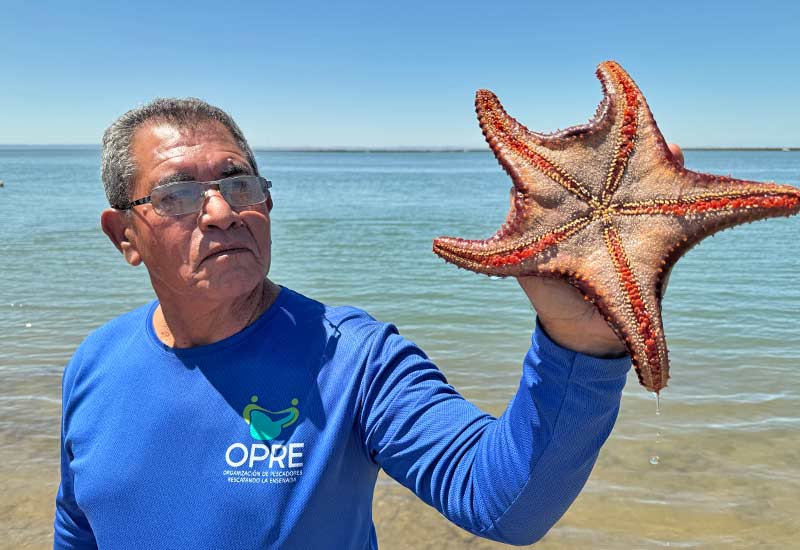
A member of El Manglito's fishermen's organization in the Ensenada de La Paz. The community has worked for over a decade on marine restoration and recovering the sea's prosperity.
Photo: Iván Carrillo
The palomilla —the informal group name for the fishermen of El Manglito, one of the last remaining fishing neighborhoods in the municipality of La Paz —understood that continuing as before meant disappearing. That year, they made an unprecedented decision: to clean the inlet and stop fishing.
They joined forces with a key ally, the civil organization Noroeste Sustentable (NOS), which provided training and ecological monitoring. With NOS’s support, the fishermen not only agreed to pause their work but also envisioned the future they wanted: an inlet with abundant resources, respect for the law and a renewed relationship with the authorities.
They dove to the seabed and sifted through the mangroves. Tires, air conditioners, toilets, nets, clothes—on that first day alone, they removed 30 tons of waste. Local authorities helped transport it to its final destination. Then something happened that hadn’t occurred in years: tiny scallops began to settle in the sand, right where there had once been only debris.
The second step was harder: six years without fishing. The pangas and equipment were stored away. Hunger, tight budgets, and nightly community patrols followed. Hubert sums it up: “It’s easy to say, but try to do it—try to stop working yourself. If you have two jobs, try leaving one and living off the other.”
To endure, some fishermen received a modest weekly stipend—less than 2,000 pesos—for planting scallops, a fraction of what they once earned. Yet that sacrifice, Hubert says, was the palomilla’s first great achievement: proof that fishermen could also be the sea’s guardians. It was possible to care for the ocean without ceasing to be a fisherman.
Years later, when fishing resumed, it did so under clear rules: size limits, catch quotas, and vigilance to prevent repeating past mistakes.

A boat beached under the shade of a tree in El Manglito. In this historic fishing neighborhood of La Paz, daily life is intertwined with the sea at every turn.
Photo: Eunice Adorno
Discipline didn’t come overnight. The fishermen learned to control their tempers, to debate for hours without arguing after five minutes, and to stop illegal fishing without violence—though not always peacefully, and with police support when necessary.
Fishermen illegally entering the Inlet refused to accept the agreement, and confrontations escalated. Hubert recalls one such scene and looks at José Luis Alameda, the 73-year-old gray-haired fisherman accompanying him:
“How many times did they throw an axe at us for keeping watch?” he asks.
José Luis smiles with resignation and nods slowly, as if replaying an old memory. Yes, more than once.
There were threats, insults, even a companion stabbed. The people of El Manglito had a reputation for being combative, but this time they chose another path. Their first rule: don’t respond with violence. Instead, talk, ask for respect, and explain that what they wanted was to bring back the species. Surveillance was thus maintained.
In 2016, after more than five years of closure and cleanup, they took the next step and legally registered the Organization of Fishermen Rescuing the Inlet (Organización de Pescadores Rescatando la Ensenada, or OPRE). With their constitutive act and internal regulations, they formalized what had already become a shared project. Today, OPRE counts 99 members—down from the original 109—though only about 25 to 30 remain active in fishing and restoration. Their ages range from 37 to over 70, and among them are 87 men and 22 women. Their internal policy is to include young people as partners and give older members a place to pass on their knowledge.
Today, life in El Manglito cannot be understood without OPRE. The acronym is everywhere: in meetings, in homes, in pangas. It has become part of the neighborhood’s identity.
José Luis Alameda is a man of the sea. The sun has carved its marks on his face, and his back bears the weight of the years. He walks slowly in a light shirt, but when he speaks of the ocean, his voice grows strong. At 73, he says with conviction, “One day we’ll see the old banks full again.”
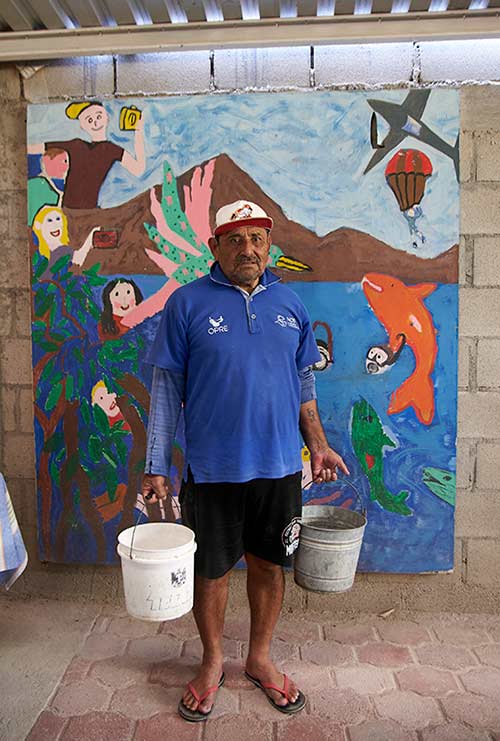
A fisherman from El Manglito arrives with his catch at OPRE headquarters. The community classifies and prepares scallops from the Ensenada de La Paz, obtained through sustainable practices.
Photo: Eunice Adorno
His story began at seventeen, when he worked aboard tourist pangas off the Los Cocos and El Continental hotels in La Paz Bay. It was the 1970s, and the bay was his classroom: showing visitors around, learning to read its moods, and feeling on his skin the gusts of wind he called “the Holy Spirit”—the one that brings reflection and guides those who live by the water.
Over time, he left tourism behind and devoted himself entirely to fishing catarina clams, scallops, and mussels. He knew the bounty of the traditional banks—the natural deposits where clams and scallops were extracted for generations. These were sites inherited from fathers to sons, true reserves of food and sustenance that today survive more in memory than in reality. Yet José Luis still names them in the present tense, as if speaking about them might bring them back.
For him, being part of OPRE means keeping that hope alive. Each cleanup, each regulated season, feels like a dawn breaking. Participation gives his days continuity and meaning—not only for what is taken from the sea, but for what is protected for the future. “That’s what drives me,” he says.
He speaks of the organization as one speaks of family—recalling the dives to clean the seabed and the meetings where they plan their patrols. His life has followed cycles of abundance and scarcity, but always with the certainty that the sea gives something back when it’s cared for.
It's the last Friday of June, and warm air drifts slowly through the streets of El Manglito. The pangas have returned from the sea, and fishermen arrive carrying buckets of freshly caught scallops.
"Good afternoon!"
"Afternoon."
"What's up?"
"Good afternoon."
Voices overlap as fishermen cross the threshold of a house on Inalámbrica Street. They walk directly to the back, where José Luis greets them. There, they leave their catch for what comes next: sorting, cooling, packing, and transport. That simple scene, repeated again and again, shows what OPRE’s production means today.
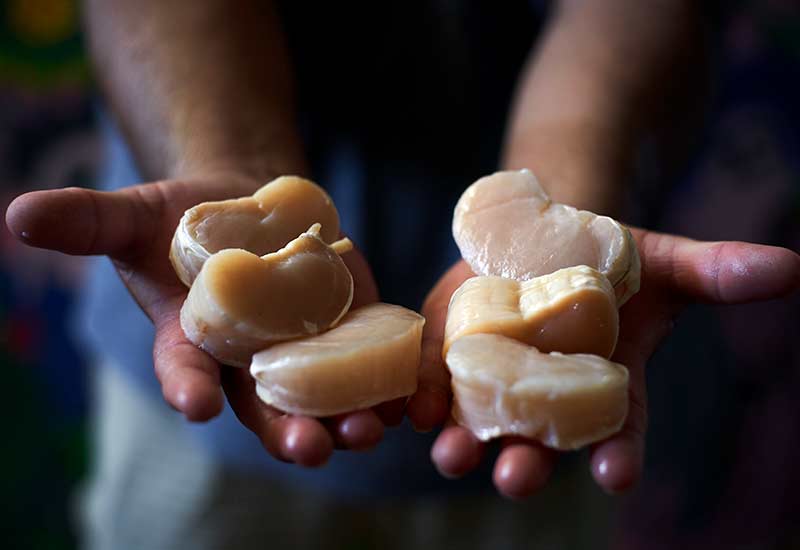
A fisherman from El Manglito shows freshly harvested scallops, ready for consumption. This prized seafood, among the finest in the Gulf of California, has come to symbolize the renewal of the Ensenada de La Paz.
Photo: Eunice Adorno
Scallops are at the heart of that work. The season begins in June, and the community has an annual quota of 1,400 kilos, distributed by internal agreement. When there’s funding for restoration, they reduce fishing to just two days a week—the rest of the time is devoted to reseeding and cleanup.
“I tell the palomilla: ‘You know what? Stop fishing. Let’s focus on restoration and fish only twice a week to meet our buyers’ needs,’” Hubert explains.
The scallops aren’t sold to just anyone. OPRE delivers them only to buyers who value the effort behind each kilo—the restoration, the monitoring, the restraint. Their current exclusive buyer is in Sinaloa, though they’ve also sent shipments to Los Cabos and Cancún.
To avoid relying solely on scallops, OPRE has sought to diversify. Three years ago, they obtained a permit to harvest up to 230 tons of mussels in their shells, though low market prices make the venture risky. “That kind of work can’t be undervalued,” they say.
Oysters offer another possibility, though competition is fierce. If they can’t produce oysters at five or six pesos apiece, the business stops being viable. That’s why they insist: the key is not to sell to everyone, but to find buyers who recognize the value of community effort.
At the same time, the fishermen have explored another path—tourism. Their project, MangliTour, offers a three-hour journey that combines storytelling and experience. The fishermen themselves guide visitors through the restored inlet, showing them how to identify a scallop in its habitat and ending the trip at El Mogote beach, a sandbar lined with mangroves, where guests enjoy mangliteño-style ceviche.
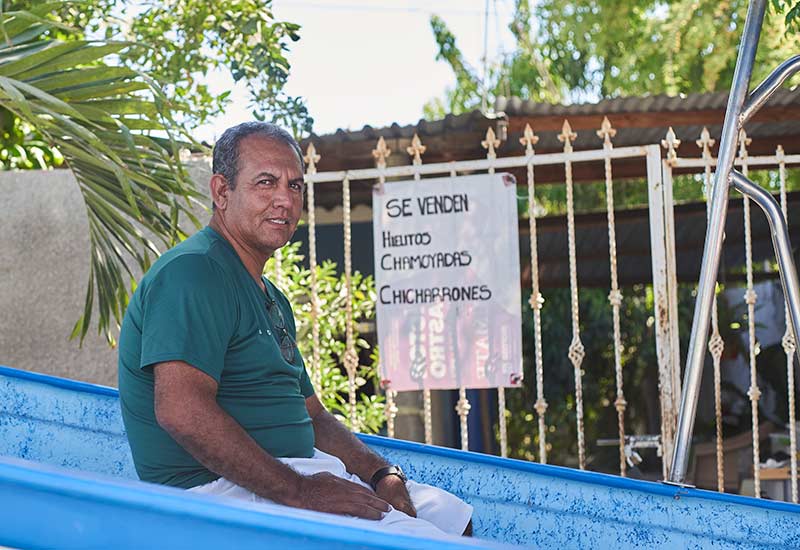
Hubert Méndez, OPRE coordinator and fisherman from El Manglito. He was part of the group that decided to stop fishing to restore the Ensenada de La Paz and recover its abundance.
Photo: Eunice Adorno
The idea is simple: more sources of income mean less pressure on fishing—and more opportunities to care for the sea.
OPRE manages a 2,048-hectare concession and works with 11 bivalve species: three types of scallops, catarina clams, two types of snail, mussels, two kinds of chirla clam, the white clam, and the chocolate clam. Since 2011, they’ve carried out annual evaluations to track progress: recording which species return, noting where invasive species emerge, and documenting reseeding for tourism purposes. To date, they’ve relocated and planted over 18,000 organisms and removed more than 60 tons of trash from the seabed—nearly 100 tons if mangroves are included. After Hurricane Norma in 2023, they filled entire pangas with debris.
Challenges remain. Illegal fishing is better controlled than a decade ago, but it persists, requiring surprise patrols and coordination with municipal and state police. Trash continues to flow down from the streams every rainy season, and the palomilla insists that the root problem must be addressed: the streambeds need cleaning, retention barriers need to be built, and mangroves must be maintained to continue filtering. And then there’s the high cost of equipping pangas for tourism—a heavy burden for families still recovering from years of scarcity.
Even so, what’s happening now would have been unthinkable fifteen years ago. Where there was once trash, there is life again: small scallops settling in the sand, clams adhering where only tires lay before. The latest season even brought a pleasant surprise—better-than-expected yields—and fishermen believe the next one will be more abundant still.

The cultivation of scallops has been one of the economic drivers for the fishermen of the La Paz inlet.
Photo: Iván Carrillo
In El Manglito, what began as a fishing ban and cleanup proved that marine restoration and community well-being can go hand in hand. Without knowing it, they were modeling what academics today call a Marine Prosperity Area. The fishermen decided they would do everything together: clean, plant, monitor, make rules, find new livelihoods, learn, and train.
For Hubert—formerly president and now secretary of OPRE’s Administrative Council—it all confirms the lesson he learned as a boy: you have to let the small things grow. Sixty years later, he repeats it as a mantra and rises each morning with the hope of recovering at least part of that lost paradise. Maybe not all of it, but enough for his children, his grandchildren, and the generations to come to see it.
Thinking about continuity also involves family. Hubert has two daughters, and although initially he didn't want them near the sea because it was too damaged, one of them chose her own path. Dayana is a fisheries engineer and now works in a larval production lab. "Someday I'd like to bring her to OPRE to introduce oysters here," he says with a smile.
Ultimately, he says, it’s about keeping new generations connected to the inlet’s care.
“Let’s change this story that drives me crazy,” he says. “‘People keep saying: there was this, there was that. I want to say: there is. There are scallops in the Ensenada de La Paz. We want to keep harvesting, we want to eat mussels, we want to eat oysters. We must change the story. Enough of saying ‘there was.’”
The local community stands as guardian of a vital wetland—its fishing heritage and the sacred Wixárika and Náayeri sites—against an unstoppable wave of real estate and tourism threatening to consume everything in its path.
By Raquel Zapien
South of Santiago Ixcuintla lies San Blas, a paradise of marshes, mangroves, and beaches at the epicenter of a quiet yet determined struggle. The community, aware of the immeasurable value of their home, has organized to defend this essential wetland, their centuries-old identity, and the sacred spaces of the Wixárika and Náayeri Indigenous peoples from the relentless advance of real estate and tourism developments that have already transformed much of the Nayarit coast. What’s at stake is not only biodiversity, but the very soul of a people unwilling to be swallowed by speculation.
Since the opening of the Tepic–San Blas Highway in February 2017, reduced travel times have unleashed a massive influx of visitors. And now, with plans for a new highway connecting Las Varas to San Blas, the real estate sector has set its sights on this still-untouched corner.

Olive ridley sea turtle (Lepidochelys olivacea) hatchlings begin their journey towards the Pacific Ocean at sunset in San Blas, Nayarit. The release is part of ongoing conservation efforts by the local turtle camp to protect this endangered species.
Photo: Brayan Artigas
More than three decades ago, Juan García Rodríguez and other visionary residents formed the Manglar Ecological Group, a citizen organization that foresaw the imminent threat. Their first line of defense has been information and community organization. They meet to dissect laws and analyze the painful transformations of neighboring towns —once small fishing villages, now tourist hubs that, in exchange for “progress,” have sacrificed their natural environments, face serious social challenges, and demand public services beyond what governments can provide.
“They don’t want the same for San Blas. Not like that.”
Through constant vigilance over both public and private projects, they achieved a historic victory in the 1970s: preventing the eviction of some 50 families living on reclaimed land at Matanchén Beach, where a mega–tourism complex was planned.
“We’ve managed, through community organization, to stop several projects,” says García, who warns of the extreme pressure from the real estate model—pressure that only intensified after San Blas was designated a Pueblo Mágico (“Magical Town”) in June 2023
Faced with the prospect that new tourism models could displace the public spaces that define their identity, perseverance has become the community’s driving force. To strengthen their cause, they’ve built networks of collaboration with organizations dedicated to environmental education under the motto: “Know to value, value to care.”
Biologist María de la Cruz Morales García plays a key role in this effort. Through photo safaris, birdwatching tours, and even underwater-diving simulations in elementary schools, she inspires children to connect with the richness of their environment. A mentor for FASOL and a member of the Gulf of California Community Wings Network, Cruz shares the ecological and cultural value of the beaches, the bay, and the four mangrove species of the La Tovara estuary—a Ramsar site of global importance that hosts all six feline species recorded in Mexico.
Each child who learns to care becomes a promise of a thriving future.
Emilio Santiaguín is another pillar of conservation. He left fishing after witnessing its decline between 2003 and 2004, when he realized overfishing was emptying the sea. He transformed his livelihood into Santiaguín Tour Expeditions, a family-run ecotourism business offering bay tours, trips to Isla Isabel, and whale-watching excursions. The change has improved the quality of life for some 25 to 30 former fishers who have embraced ecotourism.
For the Indigenous peoples of the Sierra Madre Occidental, the San Blas coast is sacred—it honors Tatei Haramara, “Our Mother the Sea.”

Children from the community of San Blas participate in a storytelling session as part of an environmental education activity to promote knowledge of the ocean and marine life.
Photo: Cruz Morales
Amid growing real estate pressure, the community also advocates for planning instruments that bind all three levels of government. For eight years, the Manglar Ecological Group and other local sectors have promoted the Local Ecological Planning Program (POEL), a municipal tool essential for regulating land use, protecting natural resources from overexploitation, and balancing economic growth with environmental conservation. Without this instrument, changing land use would become dangerously easy—opening the door to speculation.
In 2017, with support from academic, business, social, and governmental sectors, the territory was mapped, gathering vital information about its physical, social, economic, and cultural conditions. A subsequent diagnosis and scenario analysis followed. During citizen consultations, the Manglar Ecological Group and FASOL, guided by Juan García’s legal advice, mobilized the community to express their opinions. Although the final proposal was submitted in 2020, it was never followed up. Now, updating the data and finalizing the process is imperative. Protecting natural areas through this tool—established under the General Law of Ecological Balance and Environmental Protection (LGEEPA)—is crucial to prevent displacement, pollution, degradation, and biodiversity loss in the San Blas estuary system, where fishing and ecotourism remain the main livelihoods. Their shared strategy of defense is rooted in three principles: memory, order, and love for the land and sea.
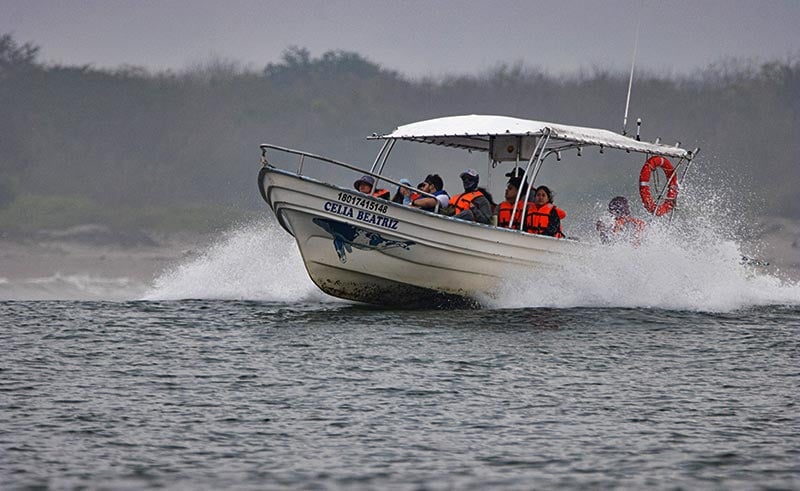
The vessel Celia Beatriz, part of Don Emilio Santiaguín's family business, sails near the San Blas coast. Don Emilio, a former fisherman, is now a tourism service provider and plays an active role in marine conservation efforts in the area.
Photo: Cruz Morales
South of Santiago Ixcuintla lies San Blas, a wetland composed of marshes, mangroves, and beaches that the local community strives to protect from the advance of real estate and tourism developments that have spread along Nayarit’s coastline.
The defense seeks not only to preserve natural capital but also to safeguard the identity of the fishing community and the sacred spaces in the worldviews of the Wixárika (Huichol) and Náayeri (Cora) indigenous peoples.
Since the opening of the Tepic–San Blas Highway in February 2017, shorter travel times have increased visitor numbers. Now, to further boost connectivity with Nayarit's beaches and attract investments, a new highway is planned from Las Varas, in the municipality of Compostela, to San Blas—fueling even greater real estate interest.
Aware that investments often target pristine natural landscapes, Juan García Rodríguez and other locals formed the Manglar Ecological Group over three decades ago, a citizen organization that anticipated what was to come.
Information and community organization became their strongest tools. They meet to review enviromental laws and analyze the changes affecting neighboring coastal towns, which have been converted into tourist hubs, have lost their natural environments, face social problems, and have a demand for public services that exceeds governmental capacity.
They don't want the same for San Blas, not like that.
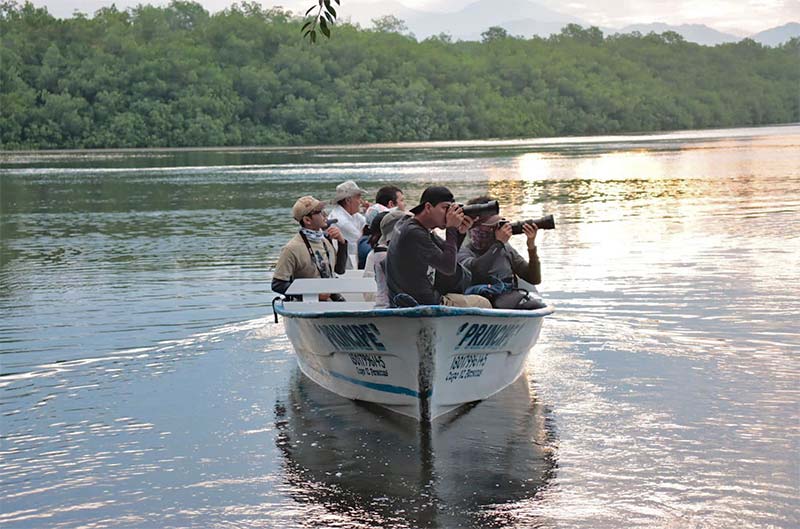
Birdwatchers navigate the mangrove channels of San Blas. Avitourism—a sustainable economic activity—depends directly on the health of these ecosystems, now increasingly threatened by land-use changes and the lack of territorial regulation.
Photo: Cruz Morales
While closely observing what happens beyond their community, they also monitor projects driven by the government and the private sector. Thanks to this vigilance, they managed to prevent the eviction of families who had settled on land reclaimed from the sea at Matanchén Beach in the 1970s, when a tourist complex was planned for development.
Juan García recalls that it was a years-long struggle until the federal authorities were finally forced to regularize the properties of about fifty families. “Through community organization, we’ve managed to stop several projects,” he says.
However, they know that at any moment, new tourism concepts could displace the public spaces that give them identity. The likelihood grows with the upcoming infrastructure projects announced for San Blas, designated a Pueblo Mágico (Magical Town) since June 2023.
“We’re under intense pressure from the real estate model that has expanded along the entire coast—we’re in a highly strained situation,” he warns.
In this context, they also advocate for planning measures that the three levels of government are bound by law to uphold.
For eight years, the Manglar Ecological Group and other local sectors have promoted the Local Ecological Planning Program —a municipal tool that regulates land use to protect natural resources from productive activities, seeking a balance between economic development and environmental conservation. Without this instrument, modifying land use will become easier.
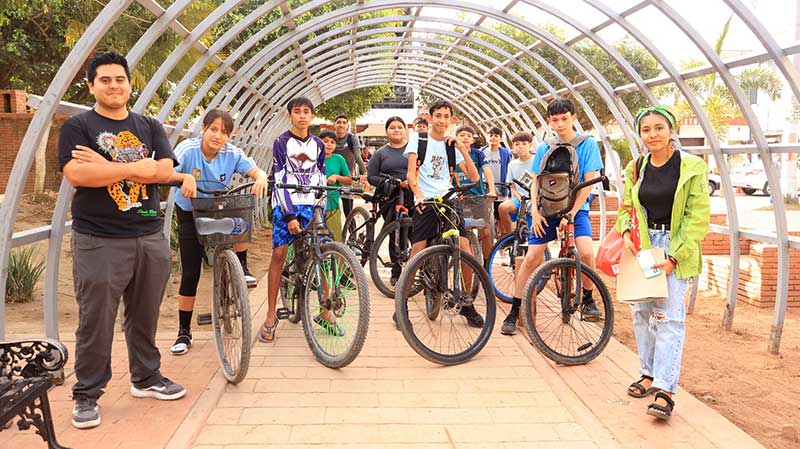
Children and young people from San Blas join a community bike tour, strengthening their biocultural identity by connecting with the landscapes and history of their town. The initiative fosters a sense of belonging and environmental awareness from an early age.
Photo: Cruz Morales
With support from academic, business, social, and governmental sectors, the territory was characterized in 2017 through the collection of data on its physical, social, economic, and cultural conditions. A diagnosis followed, along with an analysis of possible future scenarios.
During the citizen consultation process, the Manglar Ecological Group and the Solidarity Action Fund A.C. (FASOL), co-founded by Juan García, participated throughout, calling on the community to share their views and providing legal guidance. The final project was presented in 2020, but it was never followed up. Today, the information needs to be updated to finalize the procedure and safeguard natural areas through this instrument, which is established in the General Law of Ecological Balance and Environmental Protection (LGEEPA).
Potential land-use changes along the coast could displace local residents, cause pollution and environmental degradation, and lead to biodiversity loss in the San Blas estuary system—where fishing and ecotourism are the main economic activities. That is why they insist on territorial planning.
Perseverance has been their driving force. To strengthen their cause, they have woven networks of collaboration with organizations that promote environmental education. This is another form of defense: to know is to value, and to value is to care.
In this effort, biologist María de la Cruz Morales García plays a key role. She organizes photographic safaris and birdwatching tours for children. Along with other young people, she has promoted biocultural festivals and devised diving simulations in elementary schools, recreating reefs and marine fauna.
Cruz says she chose biology as a profession because she had access to similar activities in her childhood. Today, she is a mentor for FASOL and a member of the Gulf of California Community Wings Network.
In her talks, she speaks of the beaches, the bay, and the four mangrove species of the La Tovara estuary—a wetland of global importance (Ramsar site) fed by an underground spring and surrounded by the habitat of Mexico’s six feline species, all currently under some level of threat.
Here, every child who learns to care for their environment represents a promise of a thriving future.
Emilio Santiaguín also promotes conservation, but from his family tourism business, founded after leaving fishing. He also volunteers as a guardian on Isla Isabel under the tutelage of the National Commission of Natural Protected Areas (Conanp).
Between 2003 and 2004, Emilio began noticing that fishing “was in decline”—some days, he caught nothing. A biologist explained that it wasn’t just a bad season, but the consequence of overfishing and capturing undersized specimens.
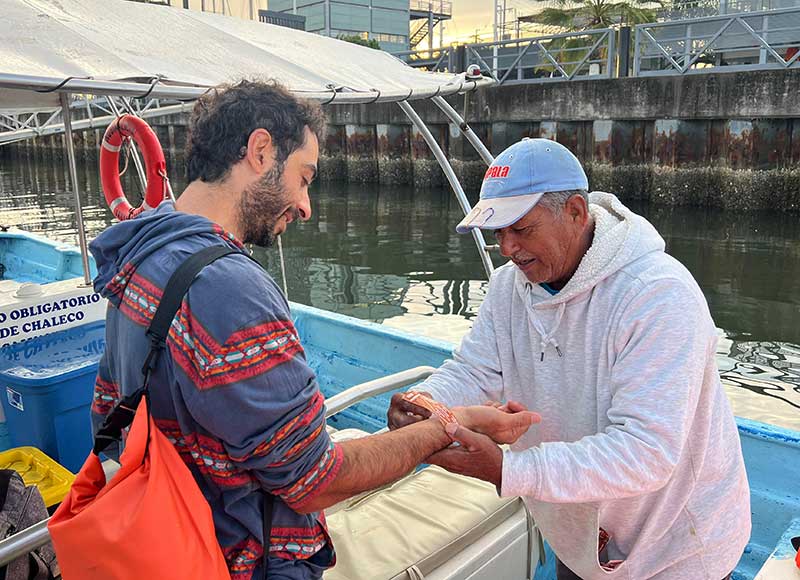
At the San Blas pier, Don Emilio Santiaguín stands as a symbol of transformation—shifting from fishing to ecotourism and dedicating his work to safeguarding the community’s marine resources.
Photo: Cruz Morales
“We didn’t know,” Emilio recalls. “And when we realized it, it hit us—we were depleting the fish ourselves, not giving them a chance to grow,” he recalls.
So Emilio traded his nets for boat tours. He obtained his permit as a tourism service provider in 2007, and Santiaguín Tour Expeditions was born—a family business offering bay tours, trips to Isla Isabel, and whale-watching excursions. Two of his children studied tourism to strengthen the project and now serve as captains, while his wife, daughter, and sister manage reservations and prepare meals for visitors.
"I believe there has been a positive change for those who decided to bet on ecotourism. Those who have dedicated themselves to offering tourism services have improved their quality of life," he affirms.
Currently, between 25 and 30 fishermen have left their nets behind to embrace ecotourism as a new way of life. It wasn’t an easy choice, but a necessary one.
Every cove visited by boat carries meaning; every route tells a story and holds cultural value. The coast of San Blas is sacred to the Indigenous peoples of the Sierra Madre Occidental, who honor Tatei Haramara—“Our Mother, the Sea” in the Wixárika language.
While some see San Blas as a paradise to exploit, others recognize its cultural and natural worth—something money can never replace.
The defense strategy they aim to share with their community rests on three pillars: memory, order, and love for the land and the sea.
These maps highlight several of the so-called Blue Spots, a scientific category used to identify coastal regions where current socioeconomic conditions—such as established diving tourism and coastal infrastructure—already favor sustainable conservation. These areas are therefore considered seeds of PAfM, where local circumstances can accelerate conservation outcomes, reduce socioeconomic conflict, and generate economic benefits more quickly.
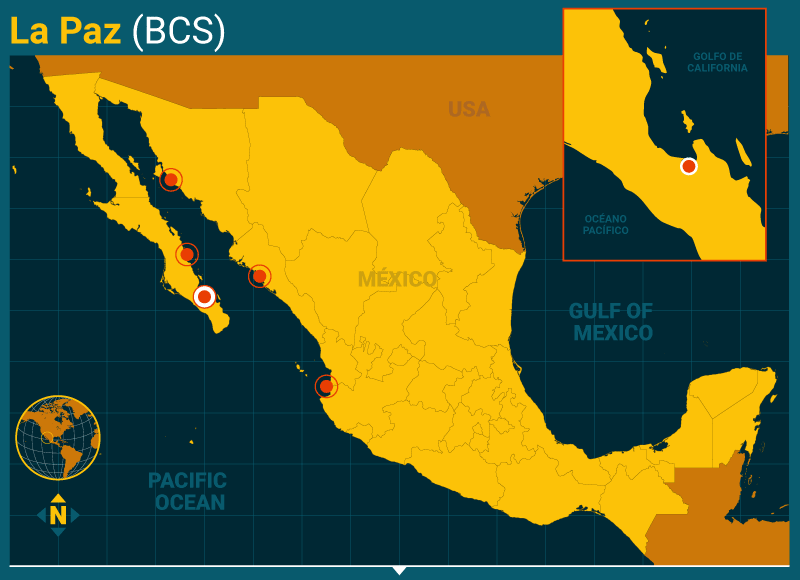
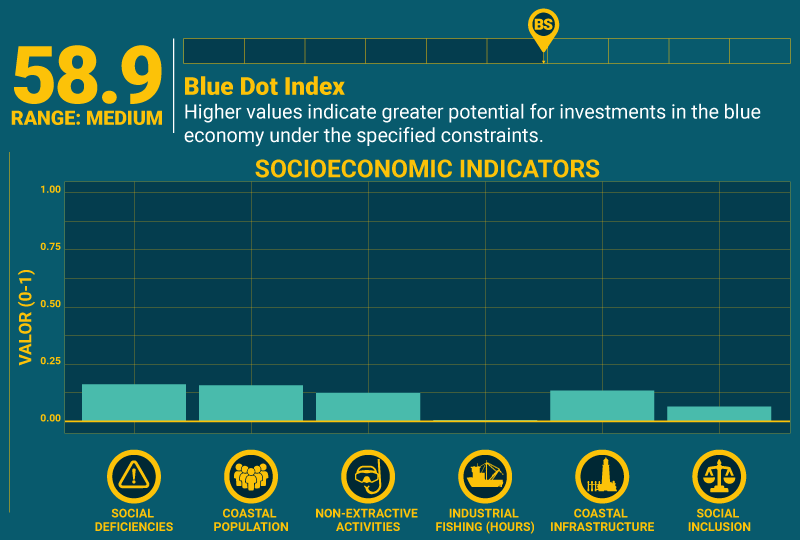
La Paz exhibits low social inclusion and limited coastal infrastructure, with little diving tourism. Fishing pressure, social deficiencies, and the coastal population are low. The untreated coastal population is high compared to its peers. The Blue Dot Index suggests moderate potential with mixed enabling and limiting factors.
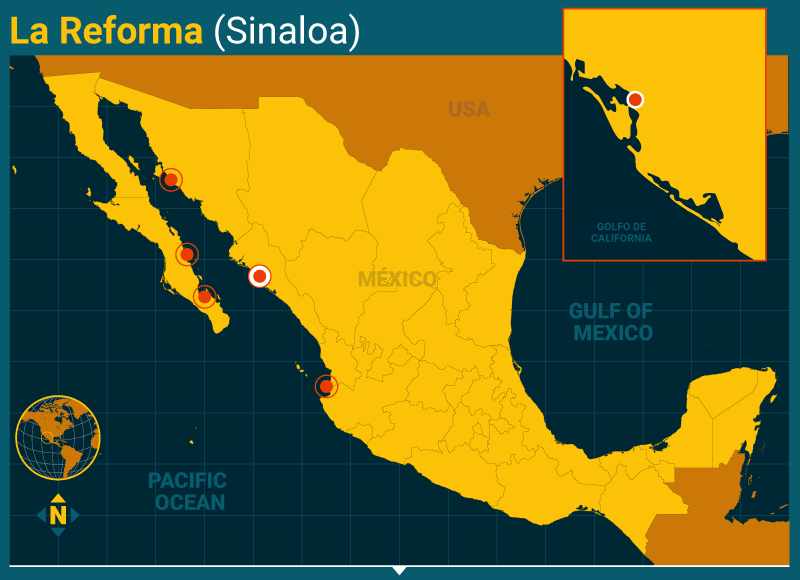
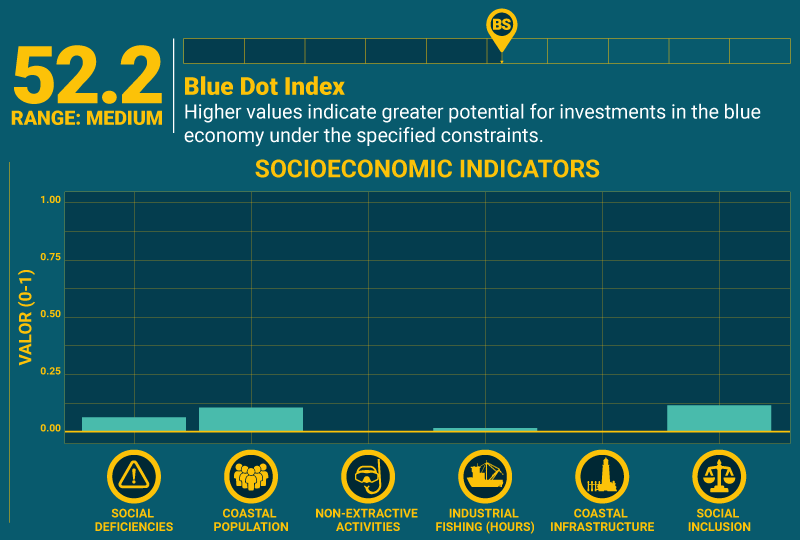
The Reforma region exhibits low social inclusion, poor coastal infrastructure, and limited diving tourism. Industrial fishing pressure, social deficiencies, and the coastal population are low. The undeveloped coastal population is moderate compared to its peers. The Blue Dot Index indicates moderate potential with mixed enabling and limiting factors.
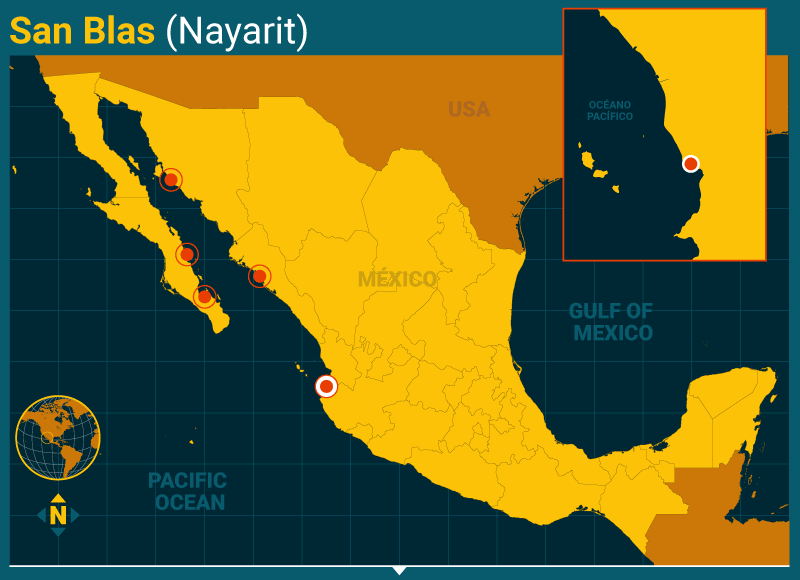

San Blas exhibits low social inclusion, poor coastal infrastructure, and limited dive tourism. Industrial fishing pressure, social deficiencies, and the coastal population are low. The natural coastal population is low compared to its peers. The Blue Dot Index suggests moderate potential with mixed enabling and limiting factors.
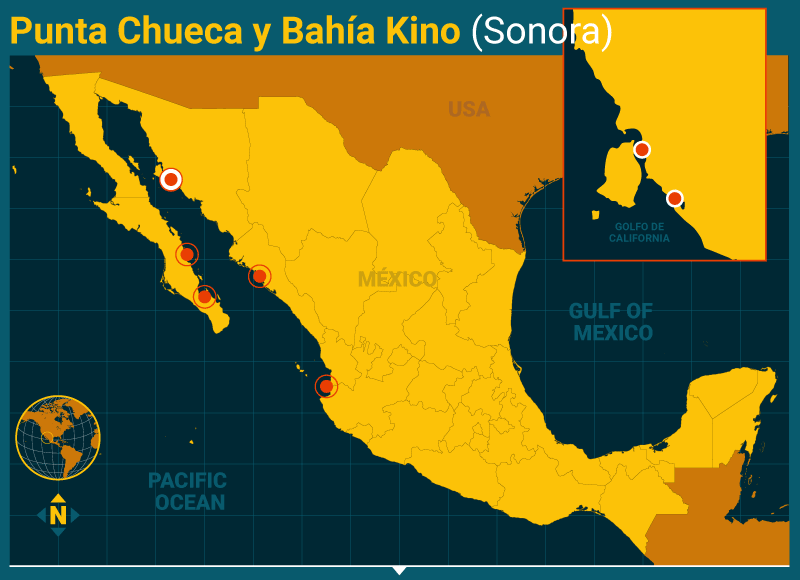

Punta Chueca exhibits low social inclusion, poor coastal infrastructure, and limited dive tourism. Industrial fishing pressure, social deficiencies, and the coastal population are low. The natural coastal population is low compared to its peers. The Blue Dot Index suggests moderate potential with mixed enabling and limiting factors.


Los Angeles Bay exhibits low social inclusion and deficient coastal infrastructure, with low levels of dive tourism. Industrial fishing pressure is low, social deficiencies are low, and the coastal population is small. The natural coastal population is low compared to its peers. The Blue Dot Index suggests moderate potential with a combination of favorable and restrictive factors.
Foundations for prosperity
The Blue Dot Index shows that many municipalities in the Gulf of California already have the foundations for Marine Prosperity Areas. While infrastructure and social inclusion are still developing, low industrial fishing pressure and emerging tourism activities offer fertile ground for growth. Communities like Bahía de Los Ángeles, Puerto Peñasco, and San Blas are well-positioned to strengthen non-extractive economies, while La Paz, La Ventana, La Reforma, and Punta Chueca can leverage their coastal identity and social capital to generate greater opportunities. Cabo Pulmo is a compelling example of what can be achieved when conservation and community prosperity converge, inspiring the next generation of Marine Prosperity Areas in the region.